
 |
NATURAL CURVES SURFBOARDS |
| Home | | | Surfboards | | | Design | | | Surfing & Media | | | Surfcast | | | About NC | | | Custom Orders | | | Contact |
| |
DESIGN TOPICS |
| |
BOTTOM CONTOURS |
| |
|
| |
November 3, 2024 |
| |
|
| |
There are several bottom contour configurations found in contemporary
surfboard design. They may be divided into three primary groups - flat, convex,
and concave bottoms. All may be incorporated in any type of surfboard, although
most are relevant to specific types of boards.
FLAT BOTTOMS Some shapers employ flat bottoms in their designs, but a flat bottom is hard pressed to add any performance features to a surfboard - shortboards, step ups, semi guns, XXL guns, mid lengths and eggs, or longboards. Although fast, flat bottoms provide no lateral stability, lift, or leverage. Bottom contours with flat areas combined with other bottom contours can be an exception. Combined with vees, tri planes, soft rolled surfaces, and concaves, bottoms with flat features move beyond their safe, neutral, vanilla performance features and contribute to developing acceleration, projection, speed, maneuverability, and control. CONVEX BOTTOMS are any combination of rail to rail planes and curves that descend below the rail line of the surfboard. Convex bottoms generate lift and reduce drag by reducing wet surface and maximizing laminar flow. Tri plane entry and wide point to panel vee is a very basic and simple bottom design. Tri planes create lift and reduce drag. It's a very fast bottom, as it planes in the face of a wave with less wet surface, it's very forgiving as it lifts the forward rails out of the water in critical sections, and it initiates turns with ease as the tri plane entry transitions from rail to rail with minimum effort. Panel and spiral vees from wide point to tail also offer fluid rail to rail transitions as well as acceleration, projection, speed, and maneuverability. The combination of tri plane and vee feels like a ball bearing under a surfer. Convex designs provide great lateral stability and control, smooth transitions from rail to rail, and are very forgiving. They handle well at a full range of speeds. They are an excellent design for XXL guns. They are very functional in mid lengths, eggs, and longboards. And, they are functional, although somewhat conservative, in shortboards and specialty shortboards. CONCAVE BOTTOMS are combinations of curves nose to tail and rail to rail that ascend above the rail line. Rail rocker drops below bottom rocker creating concaves. Variations of single and single to double concaves are the primary bottom contour configurations in the modern shortboard. Concaves are one of the most complicated and contradictory design components in surfboard design. Consideration of other design variables of the board is essential to decisions about the arrangement, depth, and placement of concaves. Imagination and experimentation, trial and error, testing and observation yield efficient multiple concave bottoms. When a surfboard moves over water concaves produce lift with laminar flow channeling water under the board. Concaves produce additional lift when water runs under the bottom of a surfboard through the tail. Here the board's outline curves into the tail reducing surface area. The water flowing through the tail under the board is compressed into less surface area creating additional lift. Try placing both sides of a spoon under a faucet of flowing water. The concave side of the spoon pushes away from the flow of water. The convex side of the spoon sucks into the flow of water. It's a classic example of water moving over a surface and creating either lift or drag ! Working effectively with lift and drag is key to designing concaves into the bottom of a surfboard. Efficient multiple concaves feed water under a surfboard then release water through the fins and tail of a surfboard. When a surfer weights the rail and bottom of a surfboard he compresses the water, channeling it through the concave array. The rocker, template, rail, and fin arrangement provides this compressed water with an avenue of escape - out through the tail section of the board. This phenomena excentuates the power, acceleration, projection, and speed of the surfboard through it's turns. Tuning each variable and their interaction with the other variables determines the performance characteristics of the surfboard. Most concave bottoms are one of two primary concave designs single concave or single to double concave. Single concave features shallow concave or vee in the entry, shallow single concave from entry to wide point increasing in depth to maximum depth just in front of the fins, with concave decreasing in depth through the fins to the tail. The single concave may transition to vee behind the fins. A single to double concave features shallow concave or vee in the entry, shallow single concave from entry to wide point increasing in depth to maximum depth just in front of the fins, and double concave from this point through the tail. The double concave may also transition to vee behind the fins. Holding the other primary surfboard design variables constant, single concaves tend to be looser than single to double concaves and have the potential for greater variation in turning radius. They have more control and predictability. The spine of a double concave offers more lift to the center of the bottom of a board. Single to double concaves have a consistent predictable turning radius. REVERSE VEE BOTTOM designs feature vee in the nose and entry - even optionally to the wide point - that transitions to very shallow vee, flat, or concave bottom contours from the wide point through the fins to the tail. The vee in the front half of the board is deeper than the bottom contours in the back half of the board. Early shortboard designs often featured these or similar bottom contours. The "mini gun" designs of the late 60s that became prototypical shortboards throughout the 70s and 80s often featured vee in the entry, flat or shallow concave from the wide point to near the fins, and panel vee or alternatively spiral vee through the fins and tail. As the down rail shortboard designs of the 70s and 80s evolved it was common for the vee in the nose and entry to be reduced or eliminated entirely and the vee from wide point to tail or in the area of the fin or fins increased in depth. The multiple concave shortboards that evolved from the glass slippers of the early 90s also rarely if ever featured vee in the nose and entry. Reverse vee designs reintroduce convex entry to laminar flow in bottom contours. Reverse vee designs offer generous portions of power, projection, and acceleration. They are most relevant for step ups, semi guns, and XXL guns. Reverse vee designs offer the most power of all bottom contours. Credit to Maurice Cole and Tom Curren for the emergence of reverse vee in contemporary surfboard design. Surf history and culture found both of them living and surfing in Southwest France in the 80s. In 1990 they collaborated on a reverse vee design that was at the core of Curren's trials to title World Championship run in 1991 and became an iconic functional design. |
| |
|
| |
BOTTOM CONTOUR PERFORMANCE and IMAGES |
| |
|
| |
CONVEX BOTTOMS offer more momentum than any bottom contour. By their design and nature they maintain their speed, trim, and glide better than any bottom design. Tri plane contours in the entry and wide point engage waves with less wet surface, create lift, and reduce drag. They initiate fluid rail to rail transitions off the front foot. Panel and spiral vees from wide point to tail also offer fluid rail to rail transitions as well as acceleration, projection, speed, and maneuverability. |
| |
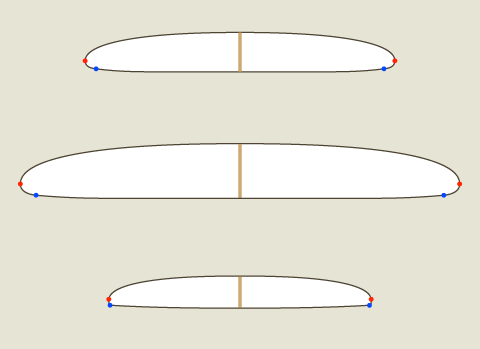 |
| |
CONVEX TRI PLANE to PANEL VEE |
| |
Convex tri plane to vee designs maximize laminar flow and minimize drag. They offer excellent turn and trim features. They are the ultimate design for maintaining and controlling speed. |
| |
|
| |
CONCAVE BOTTOMS are the primary bottom design for contemporary high
performance shortboards, step ups, and semi guns. They are created by the
juxtaposition of bottom rocker and rail rocker. They feature more curve in the
rail rocker than in the bottom rocker. Concave bottoms are generally single
concave nose to tail with the concave getting progressively deeper until the
just in front of the fins before fading through the tail, or single to double
concaves featuring the same progressively deeper single concave into the fins
with double concave fading through the tail. Some double concaves feature the
double concave further into the bottom from the tail. When tuned correctly in a
design concaves amplify laminar flow and create lift acceleration, projection,
speed, and maneuverability.
Single concave and single to double concave performance varies moderately. Water flows in a smooth arc from rail to rail in single concaves enabling powerful, stable, and predictable turns. The smooth rail to rail water flow enables maximum controlled power through turns and nuanced turning radii for a wide variety of turns and barrels in different waves. The way water flows from the rail the peak of the double concave at the stringer creates additional lift at the center of the bottom of the board and with it's spine offers directional stability through turns. Single concaves may have a touch of double concave or vee in the last 4" to 5" of the tail. The short double concave or vee adds an extra element of release, stability, and control. Moving the double concave feature forward in the bottom contours yields the classic single to double concave. |
| |
 |
| |
CONCAVE VEE to SINGLE CONCAVE |
| |
Concave designs have significant curves and fit into and source energy in critical sections and waves. They offer an exciting and powerful blend of acceleration, projection, speed, and maneuverability. |
| |
LINK Single and Single to Double Concave Designs Design Topics essay |
| |
|
| |
REVERSE VEE BOTTOM designs feature vee in the nose and entry - even optionally
to the wide point - that transitions to very shallow vee, flat, or
concave bottom contours from the wide point through the fins to the tail. The
vee in the front half of the board is deeper than the bottom contours in the
back half of the board. Early shortboard designs often featured these or
similar bottom contours. The "mini gun" designs of the late 60s that became
prototypical shortboards throughout the 70s and 80s often featured vee in the
entry, flat or shallow concave from the wide point to near the fins, and panel
vee or alternatively spiral vee through the fins and tail. As the down rail
shortboard designs of the 70s and 80s evolved it was common for the vee in the
nose and entry to be reduced or eliminated entirely and the vee from wide point
to tail or in the area of the fin or fins increased in depth. The multiple
concave shortboards that evolved from the glass slippers of the early 90s also
rarely if ever featured vee in the nose and entry. Reverse vee designs
reintroduce convex entry to laminar flow in bottom contours.
Bottom contours coupled with rocker, profile, and rails create the laminar flow of water along the bottom of a board. Correct laminar flow maximizes lift and minimizes drag. In reverse vee designs the vee forward transitions to flat or concave contours aft. The vee forward in the design settles a board into the water and the transition to reduced vee, flat, or concave feeds the water under a board from the wide point to the tail maximizing lift, acceleration, and speed. Vee or double concave from the fins to the tail coupled with nuanced rocker and rails releases the water flowing under the bottom of the board reducing friction and minimizing any drag. The performance features of reverse vee bottoms come from the juxtopisiton of the curve of bottom rocker with straighter rail rocker. This combination creates a board that goes rail to rail with ease and provides speed and power through turns. The vee forward in the design creates easy rail to rail transitions and the flat or concave bottom from wide point to tail or between the fins provides controlled and predictable acceleration, projection, speed, and maneuverability. Nuanced tail rocker and rails release water off the tail of the board. Credit to Maurice Cole and Tom Curren for the emergence of reverse vee in contemporary surfboard design. Surf history and culture found both of them living and surfing in Southwest France in the 80s. In 1990 they collaborated on a reverse vee design that was at the core of Curren's trials to title World Championship run in 1991 and became an iconic functional design. |
| |
 |
| |
REVERSE VEE VEE to SPIRAL VEE to SINGLE CONCAVE |
| |
Reverse vee designs offer generous portions of power, projection, and acceleration. They are most relevant for step ups, semi guns, and XXL guns. Reverse vee designs offer the most power of all bottom contours. |
| |
LINK Reverse Vee Designs Design Topics essay |
| |
|
| |
< top of page > |
| |
FIN CONFIGURATIONS and PERFORMANCE |
| |
|
| |
August 18, 2024 |
| |
|
| |
Fin configurations and fin performance vary by surfboard classes and
designs and by the fin's designs and their placement. Some fin configurations
are completely unique to some surfboard designs, yet most will function and
perform well with any design.
The primary fin configurations are single fins, 2 + 1s, twin fins, thrusters, and quads. Single fins and 2 + 1s are common to most longboard and mid length designs. Twin fins, thrusters, and quads are also employed on those designs with excellent results. However, twin fins, thrusters, and quads are most common to shortboards, semi guns, and XXL guns. Twin fins are the primary and preferred fins for Fish designs. Here is a comprehensive anatomy of fins. Contemporary and historical surfboard classes and surfboard designs and multiple fin configuration options offer surfers a vast spectrum of performance features not only from each configuration, but also by nuanced fin templates, dimensions, foils, placement, and juxtaposition to each other. Here is a brief description of various fin foils. |
| |
|
| |
FIN CONFIGURATIONS
Single Fins have been around as long as there has been fins on surfboards. They were the staple of the classic post World War II longboards. In the 1960s LB Single Fins evolved from nearly square D fins to life form Progressive fins to High Aspect flex fins. |
| |
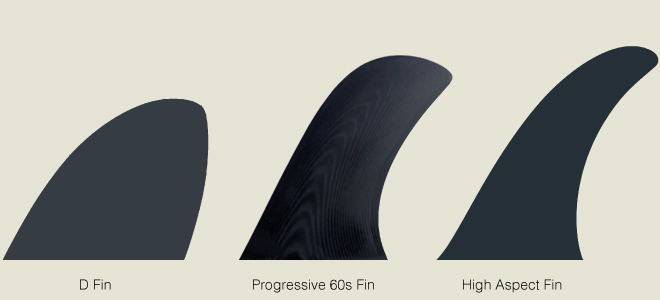 |
| |
Shortboard Single Fins were the primary fin configuration for shortboards at the beginning of the shortboard revolution in 1966 - 67. Neutral and High Aspect templates were common. Neutral fins were more pivotal. High Aspect fins had more flex and offered more acceleration, projection, and speed. |
| |
 |
| |
2 + 1s were introduced to early single fin shortboard designs to promote greater control and maneuverability. In the 1980s the 2 + 1 configuration was applied to emerging contemporary longboard and mid length designs. |
| |
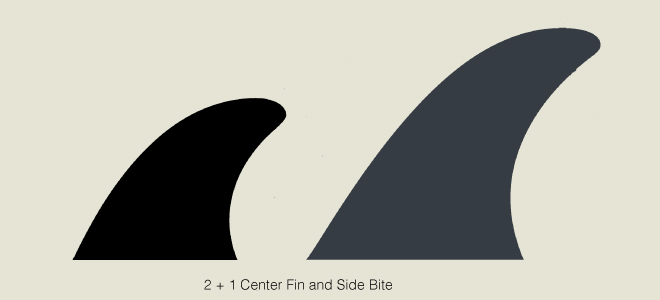 |
| |
Although Twin Fins date to Bob Simmons in the 1940s and were used quite functionally by brothers Nick and Bear Mirandon from La Jolla in the mid 1960s the configuration gained traction in the mid 1970s when surfed to great affect by Hawaiian Reno Abellira and Australian Mark Richards. Fish designs pioneered by Steve Lis and Jeff Ching featured Twin Keel Fins. |
| |
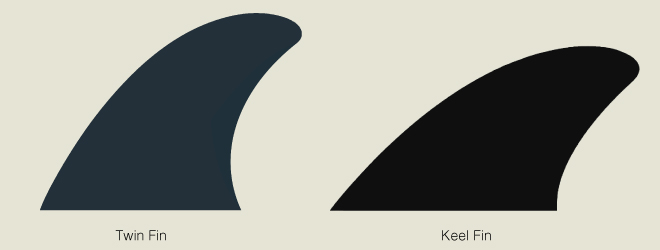 |
| |
The Thruster Fin configuration was pioneered by Australian Simon Anderson in 1981. The design offered superior stability and control compared to twin fins. The thruster configuration has been the primary fin configuration for decades. |
| |
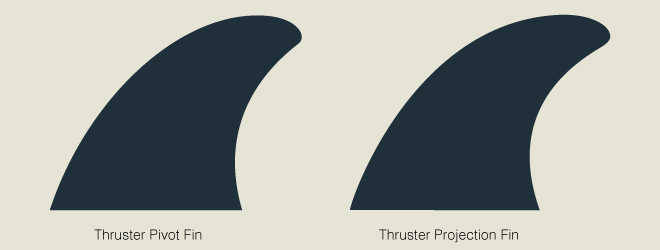 |
| |
The Quad Fin configuration was introduced by Australian Glen Winton in 1982. The design is an adaptation and extension of the twin fin concept that no center fin reduces drag and increases acceleration and speed. One often forgotten version of a quad was the "Twinzer" featuring a small fore fin in front of a typical twin fin. The fore fin prevented cavitation and added stability and control to previous twin fin designs. The primary quad configuration, though, features a thruster like forward fin and a moderately smaller trailing fin. |
| |
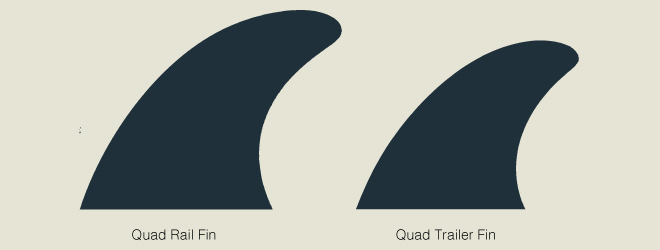 |
| |
|
| |
FIN LAYOUTS, PLACEMENT, and PERFORMANCE
Single Fins: Single fins are pivotal by nature. The absence of 2 + 1 side bites, twin fin, thruster, or quad creates a single pivot point to turn a board from rail to rail. Single fins create smooth arching down the line turns and are most efficient when surfer, board, and wave are in sync with each other. They were historically and currently the primary fin configuration for classic LBs offering pivotal turns, stability and control in trim and on the nose. LB single fins evolved from the D fin of the early 1950s and early 1960s featuring a nearly rectangular template to Progressive fins designed for turns, trim, and nose riding in the early to mid 1960s to the High Aspect Flex fins pioneered by George Greenough in the mid 1960s. The D fins offered excellent stability for trim and nose riding, however they were difficult to turn. The Progressive fins offered the same stability in trim and on the nose and introduced significant maneuverability. The High Aspect flex fins were also equally efficient in trim and on the nose, but offered substantially greater acceleration, projection, and maneuverability and ultimately became the fin of choice for traditional classic longboarding. Single fin size and placement affect performance. D fins have equally long base and depth dimensions featuring a 9" to 10" base and are 9" to 10" deep. Without exception the trailing edge is placed very near the tail of a board. D fins best feature is stability in trim and on the nose. Progressive fins feature a moderate 7" to 8" base and a deep 9" to 10" full profile. Progressive fins are placed near the tail like D fins. They offer the same stability in trim and on the nose with greater maneuverability. High Aspect fins also feature a moderate 6" to 7" base, a deep 9" to 10" or deeper profile, and a flexible foil from base to tip. The solid base offers control in trim and on the nose and the flexible high aspect foil facilitates fluid rail to rail transitions and power and projection out of turns. High Aspect flex fins may be placed forward and aft to vary performance. Generally, further forward creates a more drawn out turn and further aft a more pivotal turn. |
| |

 |
| |
|
| |
These images illustrate LB Single Fin placement. D fins and Progressive 60s fins are placed within an inch or two of the tail. High Aspect fins are placed approximately the length of the base or length of base plus a few inches from the tail. Placed further back High Aspect single fins will have a tighter turning radius. Placed further forward they will have more projection. |
| |
|
| |
Single Fins were also the original fin configuration for surfboards at the beginning of the shortboard revolution offering the same performance features as they did for classic longboards. Shortboard single fins featured Neutral and High Aspect templates and foils. Neutral fins were more pivotal. High Aspect fins evolved from Greenough's flex fins. They offered more acceleration, projection, and speed. Shortboard single fin templates resemble life form fins common to sea mammals and fish, such as dolphins, whales, and tuna. Common shortboard single fin dimensions are 5" base and 8" deep. Single fins remained common during the first decade of the shortboard revolution, but the evolution of surfing and surfboard design saw most surfers transition to 2 + 1s, twin fins, and ultimately thrusters and quads. |
| |
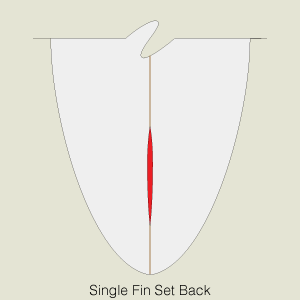
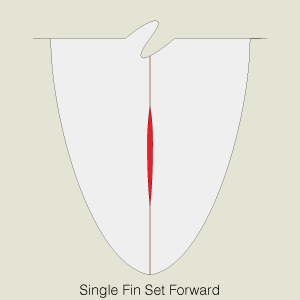 |
| |
|
| |
These images illustrate shortboard Single Fin placement. Single fins are pivotal by nature whether neutral or raked. Neutral templates are more pivotal than raked templates. Placed further back single fins will have a tighter turning radius. Placed further forward single fins will have more projection. |
| |
|
| |
2 + 1s: 2 + 1 fin configurations perform very much like single fins coupled with features of thrusters. The side bites offer substantial performance features. They offer more control, hold trim better in steep and critical waves, and provide greater projection and acceleration out of turns. The additional surface area of this configuration compared to a single fin allows shapers and surfers, if they chose, to use a smaller center fin as the rail bites provide or make up for the reduced size of the center fin with their surface area. This provides more acceleration and speed, better rail to rail transitions, and more maneuverability. The juxtaposition of the center fin and rail bites and the placement of the configuration also affect performance. The closer the trailing edge of the side bites to the leading edge of the center fin the more pivotal the board will turn. Separated further, the more down the line the board will turn. Additionally, the same configurations placed closer to the tail will be more pivotal and placed further forward from the tail will offer a longer arc and more projection. The combinations are nearly limitless and offer nuanced performance variations. |
| |

 |
| |
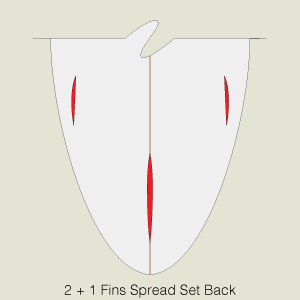
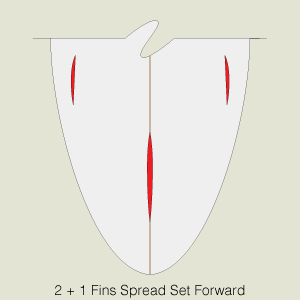 |
| |
|
| |
These images illustrate 2 + 1 fin placements. 2 + 1 fin sets can be clustered tight or spread further apart. Clustered tight they will be more pivotal. Spread further apart they will have more projection. Placed further back 2 + 1 fins will have a tighter turning radius. Placed further forward 2 + 1 fins will have more projection. |
| |
|
| |
Twin Fins: Twin fins are fast and loose. They are functional on a variety of surfboard classes and designs from shortboards to mid lengths to LBs to XXL Guns, and are uniquely suited to Fish designs. Twin fins are fast and loose because there is no center fin in their configuration reducing drag and amplifying maneuverability. Positioned near the rails, twin fins create more lift than single fins and naturally and organically transfer energy into rails. Twin fins are fast down the line, loose rail to rail, and can create a variety of tight and projected turns. Twin fin templates are similar to thruster and quad templates. Fins with less rake are pivotal by design and fins with more rake project by design. Common twin fin dimensions are larger than thrusters and quads featuring 4 5/8" to 4 7/8" bases and are 5 1/4" to 5 1/2" deep. Of note, Fish designs are a twin fin design and can feature common twin fin templates as well as keel type twin fins. Keel fins are generally 5" to 5 1/4" deep with a 7 1/4" to 7 3/4" base. Fin placement depends on the overall length and the tail width of a board. Generally, further aft will yield more pivotal turns and further forward will yield more projection out of turns. Twin fins offer excellent acceleration, projection, speed, and maneuverability. |
| |

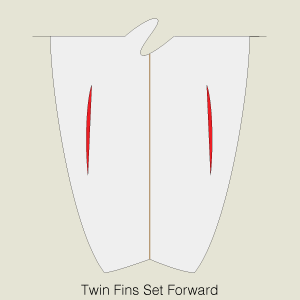 |
| |
|
| |
These images illustrate Twin Fin placement. Twin fins are fast and loose. Placed further back twin fins will have a tighter turning radius. Placed further forward twin fins will have more projection. |
| |
|
| |
Thrusters: Thruster configurations are three equal size fins working
together to provide a board with exceptional performance features. They offer
acceleration, speed, maneuverability, control, and stability. Twin fins were
the forerunner and set the stage for thrusters. Their powerful rail fins
offered acceleration, speed, and tight radius turns. Twin fin rails and fins
combined in a manner that performed radically different than single fins and 2
+ 1s fins. Thrusters combine the powerful arcs of twin fins with a center fin
offering greater stability, control, and predictability to a board's
performance.
Thruster fin designs vary by templates, dimensions, and foils. Templates vary primarily by surface area and rake. Fins with less rake will be more pivotal or neutral. A fin with more rake will offer more projection. Thruster fins for boards with wider and thicker tails can be deeper and have more surface area to maintain control and stability. Thruster fins for boards with narrower and thinner tails can be shallower with less surface area as less fin is required for control and stability. All fins cause drag. Drag slows any object down. Keeping fin dimensions to a minimum keeps drag in surfboard performance to a minimum. The rail fins and center fin in many thruster sets are the same size, although many thruster sets feature a slightly smaller center fin. The smaller center fin loosens the board without compromising stability and control. Common thruster fins have a 4 3/8" base and are 4 1/2" to 4 5/8" deep. Foils are primarily flat foil for rail fins and symmetrical 50/50 foil on the center fin. Another rail fin foil option is an inside foils or vector foil – a nuanced concave foil on the inside surface of the rail fins. |
| |
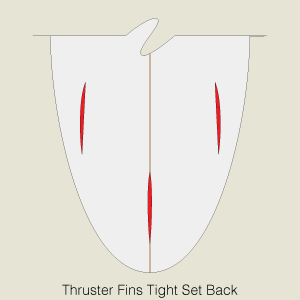
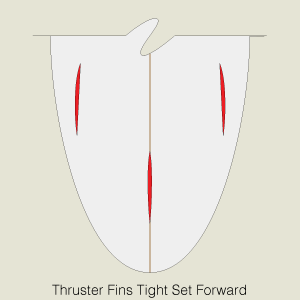 |
| |
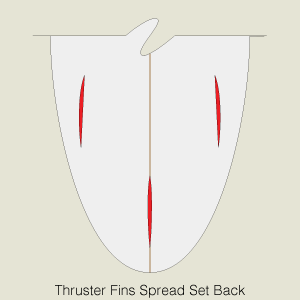
 |
| |
|
| |
These images illustrate Thruster fin placements. Thrusters can be clustered tight or spread further apart. Clustered tight they will be more pivotal. Spread further apart they will have more projection. Placed further back thrusters will have a tighter turning radius. Placed further forward thrusters will have more projection. |
| |
|
| |
Quads: Quad configurations feature forward rail fins and trailing rail fins. The forward fins are nearly the same as thruster rail fins. The trailers are slightly smaller. Templates may be pivotal or projection oriented. Common forward fins have a 4 3/8" base and are 4 1/2" to 4 5/8" deep. Common trailing fins have a 4" base and are 4" deep. Forward fin foils are primarily flat sided inside foils. Trailers may be flat sided foils for more lift, acceleration, and speed or 80/20 foils for more control and stability. Quads are very responsive and accelerate quickly with minimum effort. They excel in small fun surf, fast down the line surf, critically steep and hollow surf, and XXL surf due to their combined bases near the rail and their exceptional speed. They perform exceptionally well in critical take offs, on rail, and have speed to burn in barreling sections. The layout and position of quad configurations vary as they do in all fin configurations. Clustered close together with the trailer close to the forward fin and close to the rail the two rail fins offer two fins of base for acceleration and projection. Spread further apart the fins will pivot easier. Either layout will offer more projection placed further forward and be more pivotal placed further aft. |
| |
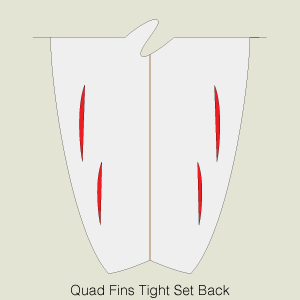
 |
| |
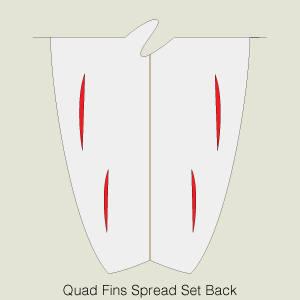
 |
| |
|
| |
These images illustrate Quad fin placements. Quads can be clustered tight or spread further apart. Clustered tight they will be more pivotal. Spread further apart they will have more projection. Placed further back thrusters will have a tighter turning radius. Placed further forward thrusters will have more projection. |
| |
|
| |
< top of page > |
| |
CLOSE TOLERANCE SHAPING |
| |
|
| |
February 14, 2024 |
| |
|
| |
Close tolerance shaping is one of the key features of the highest quality
polyurethane core polyester skin surfboards. One of the great features of the
contemporary very light, close tolerance, molded polyurethane surfboard blank
is the higher density foam near the deck and bottom of the blank and the lower
density foam of the core. When employed correctly this feature makes a very
high strength to weight ratio surfboard. In the 20 years from 1985 to 2005
Clark Foam's strength to weight ratio increased dramatically in part due to a
wide variety of close tolerance blanks and an extensive rocker program across
all classes of surfboards. There's always the potential of substandard inferior
quality surfboards caused by shaping machines machining too deep into blanks or
shaping too deep into blanks with hand tools due to using blanks that do not
feature deck rockers that mimic or approximate the surfboards deck rocker. This
is referred to as over shaping. Over shaping, particularly on the deck,
compromises the principle of close tolerance shaping and the physical
properties of the deck by shaping through the higher density skin and into the
lower density core. Over shaping polyurethane polyester surfboards by machine
or with a planer yields a surfboard with a short performance and durability
lifespan. Additionally, over shaping yields not only a weaker surfboard with
diminished physical properties, but also a heavier board as the lower density
core foam absorbs notably more resin in the laminating process.
Over shaping is such a significant issue in polyurethane polyester surfboards. It's a problem that existed long before CNC shaping machines. As noted, the nature of molded polyurethane surfboard blanks includes higher density foam on the skin and near the surfaces of the top and bottom of a blank with decreasing density towards the core of a blank. Whether machine shaped or hand shaped poor blank selection, non aligned rockers, and inadequate stringers or improper stringer glue ups are core contributors to over shaping. It is essential that the deck rocker of a design mimics the deck rocker of a blank in a manner that maximizes the physical properties of the deck. Gordon "Grubby" Clark at Clark Foam was constantly focused on the physical properties of polyurethane foam surfboard blanks and PU / Poly surfboards. His observations coupled with critical thinking initiated the concept of close tolerance shaping. Grubby introduced multiple blank molds, foam densities, stringer options, and a robust custom rocker program. US Blanks is equally committed to close tolerance shaping. They maintain and expand an extensive variety of blanks, densities, stringers, and rockers. The maximum density of a polyurethane blank is at the skin. The density decreases in the core of the blank. The deeper the finished shape from the skin of a blank the more the physical properties of the blank or core of a board are compromised. This is particularly a problem for the deck of a board due to the constant paddling and surfing impacting the deck. An appropriate blank and correct deck rocker with corresponding deck rockers of surfboard and blank are fundamental to maximizing the physical properties of the deck of a PU / Poly surfboard. It is essential for shapers to design custom deck rockers for blanks that match the deck rockers of their designs. 
CLOSE TOLERANCE SHAPING - note the design "indexed" in the blank 0.25" from the deck from tail to wide point. Maximum depth of cut is 0.31" near the nose. The entire deck of this design is a close fit to the deck of the blank and is finished in the higher density foam near the skin of the blank maximizing the physical properties of the board's deck. 
OVER SHAPING - note the design is "indexed" close to the deck of the blank in the nose and tail 0.25" from the surface of the blank. The deck of the design at the wide point is 0.63" from the surface of the blank. The critical area of the deck of the design is cut so deep into the deck of the blank the physical properties of the board's deck are severely compromised. Correct blank selection, correct custom deck rockers, appropriate foam densities, and stringer selection are the key features and the foundation of close tolerance shaping. Close tolerance shaping is a crucial component of high quality custom surfboards. |
| |
|
| |
< top of page > |
| |
FRICTIONLESS SURFBOARDS | THE PURSUIT of PERFECTION |
| |
|
| |
February 9, 2024 |
| |
|
| |
FRICTIONLESS FOILS and MAGIC SURFBOARDS
Every surfboard has a power core in the profile and foil created by the relation of bottom and deck rockers juxtaposed with a speed box in the bottom rocker. The ultimate goal of all surfboard designs is a board that paddles and catches waves well, accelerates on demand, carries speed, is maneuverable, controlable, and predictable in its perfromance. A frictionless surfboard has no friction or drag in front of the power core and speed box and no friction or drag with complete release behind the power core and speed box. These designs are magic surfboards. |
| |

|
| |
The Power Core and Speed Box correspond to the medium blue area in the foil and red line along the bottom rocker. |
| |
Friction is a force that can act on objects and decrease their
velocity or speed and ultimately their efficiency. Specifically, friction
involves two surfaces that are in contact with one another and in motion
relative to each other such as the surface of a surfboard and the
face of a wave. The absence or reduction of friction is an ideal
component of surfboard design. In the macro universe of surfing and surfboards
a frictionless surfboard can be achieved through the pursuit of perfection.
WHAT is PERFECTION ? Perfection is flawless. It is free from all flaws and defects. Perfection is a state of excellence. It is the highest degree of proficiency, skill, execution, and excellence of any thing or activity. By any standard perfection is the highest degree of quality in any endeavor. It is the extreme degree of excellence. When something is perfect it is as good as it could possibly be. Contemporary psychology generally considers perfection impossible to achieve. And it considers the pursuit of perfection a risk factor and a source of many psychological issues. No doubt this can be true when someone falls short of their goals. On the other hand we often refer to many things as perfect - a perfect wave, a perfect score, a perfect fit, a perfect day, or a perfect game in baseball. There are so many things we consider perfect. A magic surfboard is a perfect surfboard ! The pursuit of perfection in surfboard design is well worth the effort and ultimately produces continuous improvements in surfboard design and performance. WHAT is the PURSUIT of PERFCTION ? The pursuit of perfection is the process of perfecting something. Perfection is a state of quality of something being flawless. It is a continuous process of improving something until it is without flaws or defects. To perfect something such as a skill, a system, an entity, or for instance a surfboard involves making it as good as it could possibly be. Greek Philosopher Aristotle in Metaphysics described perfection as that which is complete - contains all its requisite parts, that which is so good that nothing of its kind could be better. Perfection is something that has attained its purpose. Green Bay Packer Head Coach from 1959 to 1968 Vince Lombardi famously said to his players, "Gentlemen, we are going to relentlessly chase perfection. Knowing full well we will not catch it because nothing is perfect. But we are going to relentlessly chase it. Because in the process we will catch excellence. I'm not even remotely interested in being just good." PERFECTION is a PROCESS Perfection is an ongoing, ever adapting process. In this ongoing process improvement comes through learning, innovation, and repetition. The pursuit of perfection seeks to understand and perfect the process. The Zen of Perfection is a rigorous discipline. It requires humility and an acceptance that change is integral to success. Ironically, perfection is often achieved not when there is nothing more to do or add, but when there is nothing left to do or take away. Perfection can only be achieved in a timeless and welcome environment. The pursuit of perfection struggles in a limited time frame and a resistant or hostile environment. Perfection becomes more elusive when the working environment is cluttered with friction and drag. What are the benefits of relentless pursuit of perfection ? Perfection, the process and the result, are about performance and quality. Performance and quality originate from the pursuit of perfection. ELIMINATING WASTED EFFORT When lean, timeless, and environmentally welcome techniques are applied throughout a process, friction and resistance are notably and functionally reduced. Eliminating inefficient tasks creates excellent work flow. The creative process in a welcome environment reduces needless effort, makes efficient use of time, and reduces or entirely eliminates mistakes and errors while offering results or outcomes that are ever more excellent. FRICTIONLESS SURFBOARD FOILS A perfectly foiled surfboard is is a close to frictionless as possible and offers maximum lift and minimum drag. A surfboard with a perfect foil engages waves, accelerates, maintains speed, turns on any radius on any wave in its design class and perfromance range, and extends perfromance well beyond expectations. A magic surfboard is not only a perfectly foiled design for its own design class and performance range it extends performance well beyond its intended and expected performance range. The pursuit of perfection in surfboard design includes significant emphasis on extending frictionless and controlled performance throughout a board's design class performance range, and extends performance beyond the board's expected range of perfromance. A perfect surfboard foil for any design class will paddle and enter waves as if on a yellow brick road. A frictionless surfboard design will accelerate, maintain speed, turn on any radius, and engage waves in any and every wave with control, consistency, and predictability. Within any design class the design concepts, appropriate dimensions, and foiling the geometry of the surfaces as near to or as frictionless as possible creates such perfromance. A perfectly foiled surfboard ultimately provides maximum lift and minimum drag. POWER CORE and SPEED BOX The Power Core is created in the foil of a surfboard. It is the segment of the foil that harnesses and applies the energy of a wave. The Speed Box is in the rocker. It is is the segment of the bottom rocker with the least curve. When the Power Core and Speed Box are synchronized, balanced, and functioning with each other and when there is no friction or force fore or aft of this area of the foil and rocker you have a magic surfboard. |
| |

|
| |
The Power Core and Speed Box correspond to the medium blue area in the foil and red line along the bottom rocker. This is the same image as the one above with the light blue area illustrating the distribution of volume and surface area in a contemporary shortboard and how that corresponds to the power core and speed box. |
| |
The power core of a surfboard is where a board gathers, masses, and
distributes a wave's energy and power and releases that energy and power into
acceleration, speed, maneuverability, and control. The rocker and foil,
outline, and rails absorb, distribute, and release energy from waves. The Zen
of board, wave, and surfer pursue perfection through the power core and speed
box of a board. This fundamental and primary concept applies to all classes of
surfboard design.
The combination of the core mass and the geometry - design elements and features - create the power core of surfboard. This core mass and its geometry absorb, amplify, and distribute a waves energy, speed, and power providing surfers the opportunity to ride waves. The power core is a broad concept in surfboard design. It is fundamental to all surfboard design classes, surfers, and waves. Design classes, surfers, and waves are more diverse than ever, yet all pursue perfection and excellence. |
| |
|
| |
< top of page > |
| |
MID LENGTH and EGG DESIGNS |
| |
|
| |
November 24, 2020 Updated December 12, 2023 |
| |
|
| |
OVERVIEW
The Magic Carpets of the late 60s and early 70s, that era's performance shortboards, have reemerged as today's Mid Length designs. Their performance and versatility make them one of the most popular designs in surfing. The evolution of these designs offers very user friendly surfboards for all skill levels of surfers. The same mid length board can be a high performance design and a stable and mellow cruiser depending on the surfer. With custom designs a mid length can be as unique as the demography of surfing is diverse. Mid Length designs are practical, versatile, performance capable, and user friendly. |
| |
|
| |
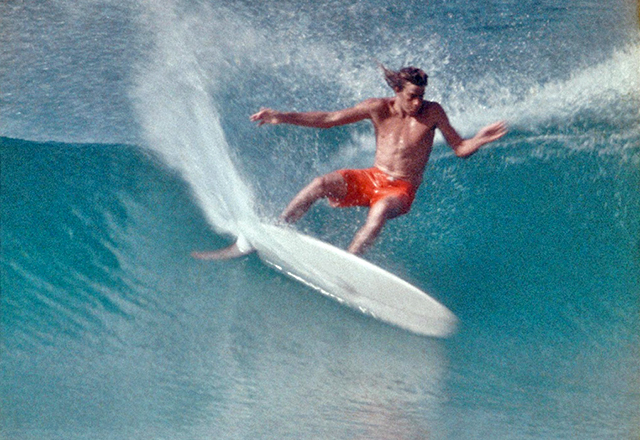 |
| |
Michael Peterson carving on an early 70s Shortboard - 2020s Mid Length |
| |
One of the cornerstones of mid length designs are Eggs. Egg designs owe
their origin to Skip Frye, who started developing his version of the design in
the late 60s and early 70s. The design offered surfers the opportunity to break
away from the traditional longboard style of surfing and add the joy of carving
and accelerating turns to the thrill of trim and glide. To this day, this
combination of surfing performance features offers an exceptionally fun surfing
experience.
Today's Egg is a functional and versatile design for all skill levels, perhaps the most versatile of all surfboard designs. The combination of performance features and the wide range of conditions wherein they're functional separates them from all other designs. Any surfer could reasonably have a single board quiver with a well designed custom Egg. The performance range of Egg designs varies from marginal knee high conditions to solid - well overhead surf, from onshore to side shore to offshore, from slop to perfection. The performance features of the design are a combination of carve and trim. No matter the skill level of a surfer, a mid length Egg is a design that is just super fun to ride. EGG ANATOMY Egg designs are a mid length, moderate to high surface area and volume surfboard. They range from 6' 6" to 8' 0" long by 20" to 22" wide by 2 3/8" to 3 1/4" thick, depending on physical features of the surfer such as their size, fitness, age, technique, performance preferences, and surfing venues. These features are also considered in the other elements of design. Egg rockers may be very relaxed speed box or low and continuous. The bottom contours are generally convex with a tri plane entry and wide point and a panel vee from wide point to tail. A spiral vee or double concave may be incorporated into the panel vee for extra acceleration in some designs. The outlines are full and moderately wide round pin tails. The rails mimic shortboard designs, soft and neutral at the nose and wide point to a hard edge at the fins and through the tail. The primary fin configuration is 2 + 1, although thruster, quad, and twin fin arrays are perfectly acceptable. Eggs perform well with all these fin configurations with each offering unique nuanced performance features. NATURAL CURVES EGGS Current Natural Curves history with Egg designs dates to the year 2000. It's a design that Rob Yuen, a true "Surf Gypsy," wanted to develop. Surfer, fisherman, drift boat guide, and arborist, Rob leaves his home in Southern Oregon every winter for an extended surf expedition to Central Baja. One of his favorite boards has been his 8' 0" Speed Egg. Over the years, Rob cross pollinated surfboard designs with his friends from San Diego who frequent the same point breaks Rob surfs. These style and glide masters have been disciples of the Skip Frye Egg School for decades. In 2000, returning from one of dozens of his expeditions, Rob had me shape him the first version of the Speed Egg design - extremely low rocker, simple round pin template, tri-plane to vee convex bottom, with a cool single fin plus side bite 2 + 1 fin configuration. Rob's original Speed Egg is a versatile surfboard that carves and planes in a very wide range of surf venues and conditions. In 2010 Rob had me shape a second generation Speed Egg. At 7' 8" his new Speed Egg is more maneuverable, offers tighter radius turns, yet maintains the glide that is key to it's performance. Rob has spent years fine tuning 2 + 1 fins for his Speed Eggs. Always the master, he recently reminded me that "style is free!" |
| |
 |
|
 |
| |
RY's 8' 0" Original Speed Egg - 2000 | |
RY's 7' 8' Speed Egg - 2010 |
| |
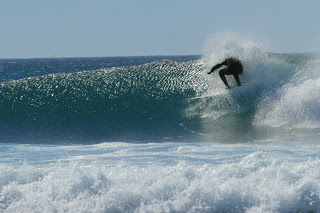 |
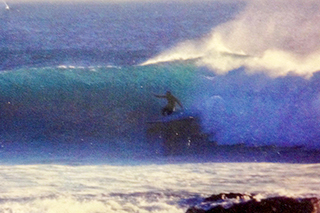 |
|
| |
RY NCRV Speed Egg | |
RY NCRV Speed Egg |
| |
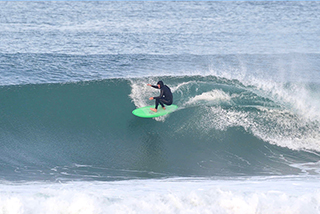 |
 |
|
| |
Scott Bass NCRV Speed Egg | Scott Bass NCRV Speed Egg |
| |
The Speed Egg, Rocket Egg, and Kestrel, and the Peregrine Egg and Pescado
Egg - the two most recent designs in the Natural Curves Egg class - continue to
evolve. The Speed Egg and Pescado Egg remain the highest volume versions of
our Egg designs. They features the fullest noses, the most surface area and
volume, and the most rail volume. The Rocket Egg, generally a little shorter
than most Speed Eggs, features less surface area in the nose and tail creating
a little more curve in the outline, a little more nose and entry rocker, and
slightly lower rail profile and volume. The Kestrel is a performance oriented
mid length. It features a similar outline to the Rocket Egg, similar lower rail
profile, and a little more entry and tail rocker than the Rocket Egg. The
Peregrine Egg is a creative and unique design incorporating shortboard and egg
design features. It offers the most perfomance features of all our mid length
egg designs. We consider it the Formula 1 of mid length designs.
The performance spectrum of these mid length egg designs ranges from trim and glide to carve, acceleration and projection. The Speed Egg and the Pescado Egg on one end of the spectrum maximize the trim and glide features and the Peregrine Egg on the other end maximizes carve, acceleration, and projection. All of our egg designs balance trim and glide with carve, acceleration, and projection. And all of these designs exceed expectations and are practical, versatile, performance capable, and user friendly. LINKS Surfboard Classes and Descriptions | Mid Lengths and Eggs The Speed Egg The Pescado Egg The Peregrine Egg The Rocket Egg The Stub Egg The Kestrel |
| |
|
| |
< top of page > |
| |
REVERSE VEE DESIGNS |
| |
|
| |
October 15, 2024 |
| |
|
| |
OVERVIEW
Reverse vee designs feature vee in the nose and entry - optionally to the wide point - that transitions to very shallow vee, flat, or concave bottom contours from the wide point through the fins to the tail. The vee in the front half of the board is deeper than the bottom contours in the back half of the board. Early shortboard designs often featured these or similar bottom contours. The "mini gun" designs of the late 60s that became prototypical shortboards throughout the 70s and 80s often featured vee in the entry, flat or shallow concave from the wide point to near the fins, and panel vee or alternatively spiral vee through the fins and tail. As the down rail shortboard designs of the 70s and 80s evolved it was common for the vee in the nose and entry to be reduced or eliminated entirely and the vee from wide point to tail or in the area of the fin or fins increased in depth. The multiple concave shortboards that evolved from the glass slippers of the early 90s also rarely if ever featured vee in the nose and entry. Reverse vee designs reintroduce convex entry to laminar flow in bottom contours. Surf history and culture found Maurice Cole and Tom Curren living and surfing in Southwest France in the 80s. In 1990 they collaborated on a design that was at the core of Curren's trials to title World Championship run in 1991 and became an iconic functional design. Their original reverse vee design featured significant vee from the nose to the wide point that transitioned to flat through the fins and tail. The primary design features of their original reverse vee design were less curve in the rail along the outline from nose to tail (rail rocker) relative to the curve along the center of the bottom of the board (bottom rocker) and amplified laminar flow created by the vee in entry transitioning to flat in the fins and tail channeling water under the bottom of the board. Over time reverse vee bottom contours would evolve from the same vee in entry to include concaves wide point to fins and tail. The concave feature further amplified the lift created by the laminar flow under the board. The transition from convex entry to concave tail can vary from in front of the wide point to behind the wide point. The reduced rail curve in the entry of the design and the amplified laminar flow offered Curren fresh dynamic performance features - excellent paddling entry, fluid rail to rail transitions, and exceptional acceleration and projection. REVERSE VEE THEORY Bottom contours coupled with rocker, profile, and rails create the laminar flow of water along the bottom of a board. Correct laminar flow maximizes lift and minimizes drag. In reverse vee designs the vee forward transitions to flat or concave contours aft. The vee forward in the design settles a board into the water and the transition to reduced vee, flat, or concave feeds the water under a board from the wide point to the tail maximizing lift, acceleration, and speed. Vee or double concave from the fins to the tail coupled with nuanced rocker and rails releases the water flowing under the bottom of the board reducing friction and minimizing any drag. The performance features of reverse vee bottoms come from the juxtopisiton of the curve of bottom rocker with straighter rail rocker. This combination creates a board that goes rail to rail with ease and provides speed and power through turns. The vee forward in the design creates easy rail to rail transitions and the flat or concave bottom from wide point to tail or between the fins provides controlled and predictable acceleration, projection, speed, and maneuverability. Nuanced tail rocker and rails release water off the tail of the board. EVOLUTION of REVERSE VEE Maurice Cole and Tom Curren captured lightning and found a pot of gold with Maurice's reverse vee designs (Maurice refers to them as EEV designs.) The first EEVs featured a bottom with vee in the entry transitioning to flat in the tail. The primary distinctive feature compared to the majority of surfboard designs of that era was straighter curves in the rail in the nose and entry blended with common curves from the wide point to the tail. This feature remains constant in the evolution of reverse vee designs. The depth and length of the vee forward in the designs, the transition to flat or concave from the wide point to tail, and integrating vee, single, or double concave in and through the fins to the tail are variables that have evolved reverse vee designs. Tuning these variables to different surfboard classes and designs, to surfers, and to conditions inevitably creates an excellent surfboard. There's something very interesting, unique, and pivotal about the function and performance of reverse vee bottom contours. The convex vee entry settles a board in the water whether paddling, taking off, or riding a wave. The transition from vee to flat or vee to concave provides lift that creates and generates acceleration, projection, and speed when a board is turned on rail. The short vee or double concave in the fins and tail provide release. The bottom rocker and rail rocker from the wide point to the fins and tail create the natural turning arcs and radius of turns. |
| |
|
| |
REVERSE VEE BOTTOM CONTOURS |
| |
|
| |

|
| |
RV PANEL VEE to FLAT |
| |

|
| |
RV PANEL VEE to SINGLE CONCAVE |
| |
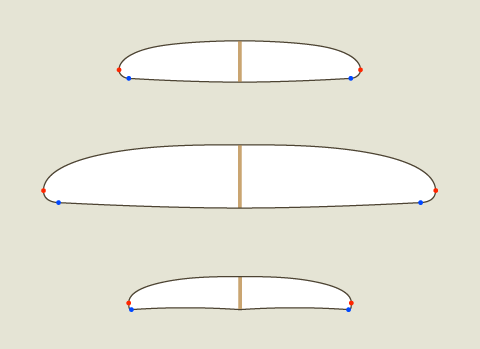
|
| |
RV PANEL VEE to DOUBLE CONCAVE |
| |

|
| |
RV SPIRAL VEE to FLAT |
| |
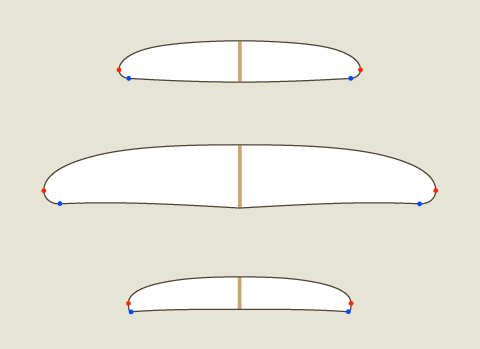
|
| |
RV SPIRAL VEE to SINGLE CONCAVE |
| |
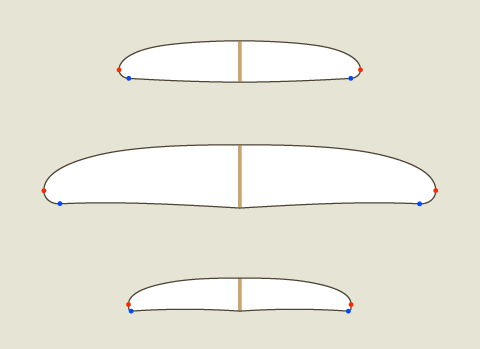
|
| |
RV SPIRAL VEE to DOUBLE CONCAVE |
| |
|
| |
REVERSE VEE RAIL PROFILES |
| |
|
| |

|
| |
RV PROFILE & RAIL PROFILE VEE to FLAT |
| |
|
| |
Profile and foil of board in black with rail profile in red. Rail profile in entry and wide point rise's above the board's profile creating vee. Rail profile is in the same plane as the board's profile in the fins and tail creating a flat rail to rail bottom contour. Zoom view |
| |
|
| |

|
| |
RV PROFILE & RAIL PROFILE VEE to CONCAVE |
| |
|
| |
Profile and foil of board in black with rail profile in red. Rail profile in entry and wide point rise's above the board's profile creating vee. Rail profile descends below or lower than the board's profile in the fins and tail creating a concave rail to rail bottom contour. Zoom view |
| |
|
| |
REVERSE VEE & SURFBOARD CLASSES & DESIGNS
Reverse vee is functional for all surfboard classes and designs. Reverse vee shortboards including step ups and semi guns feature vee entry and wide point, single concave wide point to fins, and vee or double concave fins to tail. This design offers many surfer friendly performance features including easy entry, smooth rail to rail transitions, and powerful turns on rail. A variation of this bottom features panel vee entry, subtle spiral vee at the wide point fading as it transitions to the fins, with deeper spiral vee or double concave fins to tail. This variation offers increased lift and power through turns. XXL guns feature the same vee entry to wide point, very subtle single concave of flat wide point to fins, and vee fins to tail. Mid lengths and contemporary longboards feature a similar convex bottom to XXL guns. |
| |
|
| |
< top of page > |
| |
ROCKER REVIEW |
| |
|
| |
January 3, 2024 |
| |
|
| |
Rocker is the most significant and critical component in the design of a surfboard.
Rocker is a curve observed and measured along the bottom, deck, and rails of a
surfboard from nose to tail. Bottom rocker is a curve following a straight line along
the bottom of a surfboard from nose to tail. Deck rocker is a curve following a
straight line along the deck of a surfboard. Rail rocker is a curve along the rail of a
surfboard following the outline and either the bottom or apex of the tail.
Bottom rocker is universally the first design component a shaper designs and shapes into a surfboard. The bottom and rails of a surfboard are the primary elements of design that interact with the surface of a wave. Bottom rocker and rail rocker are designed to fit correctly and functionally in the curves of a wave. Water flowing up the face of a wave in vertical and critial sections produces the most energy a wave has to offer. Rockers that fit into these critical sections therefore create the greatest amount of energy transfered into board. More energy offers more design performance. Essentially rocker allows a surfboard to source the energy in a wave providing all the primary and significant performance features required for a surfboard - acceleration, projection, speed, maneuverability, and control. Once bottom rocker is established a shaper will create deck rocker and proceed to foil the profile of a board from nose to tail and rail to rail, add bottom contours, and rails all in relation to the bottom rocker. It's essential that these additional variables compliment the bottom rocker of the board. If these design variables are not in sync, they risk working against each other. A well designed and well executed bottom rocker is the foundation of a magic surfboard. There are three primary varieties of bottom rockers in surfboard design: Speed Box rockers, Continuous rockers, and Relaxed rockers. All three rockers have important features in common, entry rocker, mid board rocker, and tail rocker. They all share these fundamental features - more curve in entry, less curve mid board and more curve in the tail. The curves accelerate in the nose and tail and are reduced mid board. All these rockers may be applied to any surfboard design - shortboards including stepups, semiguns, XXL guns, tow boards, mid legths, longboards, retro, and specialty shortboards, - as shapers design the performance characteristics into a surfboard. However, each of these bottom rockers is generally best suited for specific surfboard designs and classes. |
| |
|
| |
SPEED BOX ROCKER is a bottom curve that features relatively flat curves
through the mid section of the surboard referred to as a speed box with
accelerated curves in the entry and tail. Speed Box rockers share this feature
with continuous and relaxed rockers with the rocker mid board reduced to
maximize acceleration, projection, speed, and control of a shortboard out of
it's turns. The speed box can vary moderately in curves, length, and position.
The manner that these reduced and accelerated curves transition into each other
is critical to the successful application of this design. Smooth integrate
transitions allow the board to maximize performance. Poorly placed, abrupt, or
interrupted transitions will cause the board push water, drag and lose speed.
Speed Box rockers are used primarily in shortboards, semiguns, and XXL guns. Lengthening the straighter curves in the mid section of a board yields great acceleration, projection, and planning speed with a longer natural arc out of the turns. Shortening and increasing the curves in the mid section yields a tighter turning radius and shorter arcs out of the turns without loss of acceleration, projection, and speed. Surfers with the skill to ride these boards are able to generate acceleration, projection, and maintain speed no matter the natural arc or turning radius of the board. Shapers use these fundamental principles with moderate variations to maximize a boards performance in a variety of conditions. Speed Box rockers are the most versatile rockers in surfboard designs offering great performance across the whole spectrum of waves and conditions. |
| |
|
| |
 |
| |
SPEED BOX ROCKER
- note the area of straighter curves through the mid section of the board
with accelerated nose and tail rocker. |
| |
|
| |
CONTINUOUS ROCKER is a bottom curve with no flat spots or notable
staged transitions. They excel in the critical sections of high quality, hollow,
barreling waves. The curves flow from accelerated curve in the nose and entry,
to less curve in the mid board, to accelerated curve in the tail. Continuous
rocker curves keep boards loose and rails clean in the tight sections of
critical waves. These smooth and continuous curves allow a surfboard to turn
with ease and accelerate, project, and create speed with complete control in
critical sections.
Continuous rocker in shortboards, step ups, semiguns, and XXL guns, allows a surfboard to transition from rail to rail, turn in a variety of arcs, and project out of turns with acceleration, speed, and control. Shapers may dial up or down performance features by varying the degree of these curves. A relatively greater continuous rocker will have a tighter turning radius offering greater manuverability. A relatively flatter continuous rocker will offer more projection and a longer natural turning radius. Continuous rocker in mid length designs, eggs and longboards allows a surfboard to glide or trim at speed and turn with ease. Shapers may dial up or down these performance features, as they do in other types of designs by varying the curves. Mid length and egg designs will have rocker similar to shortboards designed to turn and accelerate when the opportunity presents itself yet glide and trim in marginal waves with less energy and power. Contemporary longboards will have rocker patterns that are flatter throughout, particularly in the nose. They are still characterized by clean continuous curves with no flat areas. The flatter nose and entry rocker of longboards creates the trim and nose riding features of the design. The greater accelerating curves from wide point to tail in longboards creates the turning features of the design. |
| |
|
| |
 |
| |
CONTINUOUS ROCKER - note the constant curve from nose to tail with accelerated nose and tail rocker. |
| |
|
| |
RELAXED ROCKER is a Speed Box or a Continuous rocker with reduced entry and tail rocker. The lower rockers profiles in the nose and tail offer performance characteristics of Speed Box and Continuous rockers in small and marginal conditions. They are designed to help a surfboard carve and accelerate through turns and hold speed and power through transitions in marginal or smaller waves. Relaxed rockers are most common to small wave boards, mid lengths and eggs, and contemporary longboards. |
| |
|
| |
 |
| |
RELAXED ROCKER - note the low relaxed rocker in the nose and tail. |
| |
|
| |
< top of page > |
| PU / PE and EPS / EPOXY SURFBOARDS | |
| |
|
| |
March 30, 2023 |
| |
|
|
PU / PE CONSTRUCTION TECHNOLOGY
PU / PE or Poly surfboards are a composite of a polyurethane foam core or shaped blank and a fiberglass fabric and polyester resin skin. PU / PE boards are reinforced with a stringer (a sandwich beam in physics) that runs vertically down the center of the board, an element that keeps the deck and bottom skins from collapsing on each other. Stringers in PU / PE boards generally made of wood, high density PU foam, or a composite of materials. PU / PE boards feature a low density core and relatively strong thin glass skin with soft flex and spring back. Polyurethane foam is a closed cell foam. PU / PE bords are known for their perfromance across the whole spectrum of waves and conditions. |
|
EPS / EPOXY CONSTRUCTION TECHNOLOGY
EPS / Epoxy or Epoxy surfboards are a composite of an EPS or Expanded Polystyrene core or shaped blank and a fiberglass fabric and epoxy resin skin. EPS / Epoxy boards are also reinforced with a stringer (a sandwich beam in physics) that runs vertically down the center of the board, an element that keeps the deck and bottom skins from collapsing on each other. Stringers in EPS / Epoxy boards may be made of wood, PVC, or a composite of materials. EPS / Epoxy boards are a board with a low density core and strong thin glass skin with stiff flex and spring back. EPS foam is an open cell beaded foam. EPS / Epoxy boards are known for their durability and for their performance in small waves and marginal conditions. |
|
POLYURETHANE / POLYESTER SURFBOARD PERFROMANCE
Polyurethane foam surfboard blanks have been the primary core or shaped blank of surfboards since 1958 when Hobie Alter, the leading board maker of the era declared, "We're not making balsa boards anymore. It's foam or nothing." With the best shapers, board builders, and surfers behind him polyurethane foam surfboards became the primary surfboard construction technology and remains so this day. The performance of the polyurethane foam, fiberglass fabric, polyester resin surfboard was notably different and progressive compared to the balsa wood core surfboard with the same fiberglass and resin skin. Polyurethane foam sandwich boards were lighter and particularly flexible compared to balsa boards. These physical properties of poly surfboards offered quickness to turns and trim adjustments and introduced the hot dog performance era of surfing, a quick and flashy maneuver oriented style of surfing. The ease of shaping polyurethane blanks compared to shaping balsa blanks allowed shapers to progress design features. Improved rockers, foils, and rails allowed surfers to be more and more creative with their techniques and styles. Thanks to polyurethane foam blanks this was truly a golden era in surfboard design and surfing. |
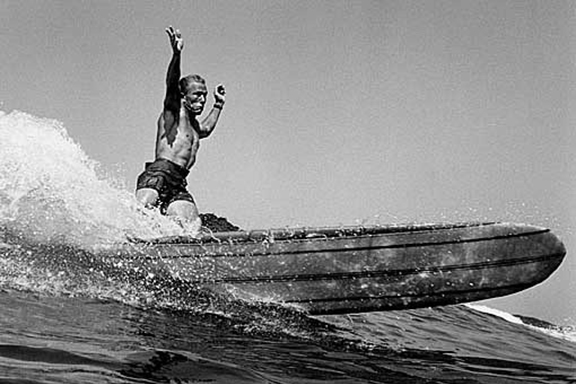
Dewey Weber Hot Dogging |
| The shortboard revolution in the late 60s was another golden era made possible by polyurethane foam. The pioneers of this epic era of transformation in surfing and design created dramatically shorter, lighter, and more flexible boards that fit in the most critical and powerful sections of waves. The physical properties of polyurethane foam were essential to this progressive and evolutionary style of surfing. Acceleration, projection, speed, and maneuverability became the foundation of progressive performance surfing. Constant improvements of polyurethane foam blanks featuring design specific molds, multiple foam densities, various types and widths of stringers, and custom rockers made shaping progressive shortboards a much easier task. |
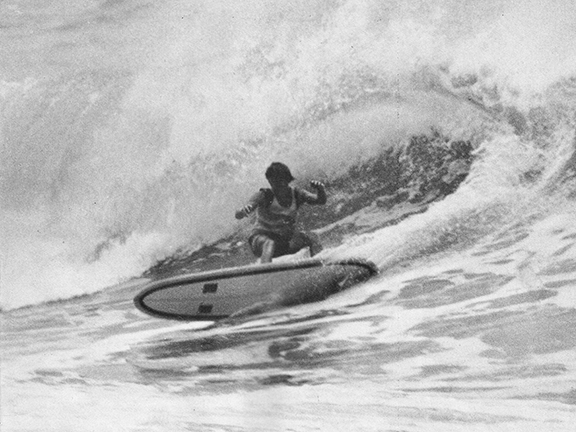
Wayne Lynch Evolutionary Shortboard |
| Today polyurethane foam core - polyester skin surfboards remain the primary surfboard construction technology for the surfboard manufacturing industry. Their performance is an essential element progressing surfing and surfboard design. Their light weight and moderate flex and spring back create great performance. A well designed polyurethane core surfboard offers acceleration, projection, speed, maneuverability, and great control. All are essential performance features. Polyurethane core surfboards are responsive and have a great feel under foot. They are known for their consistency, predictability, and control across the whole spectrum of waves and conditions. |
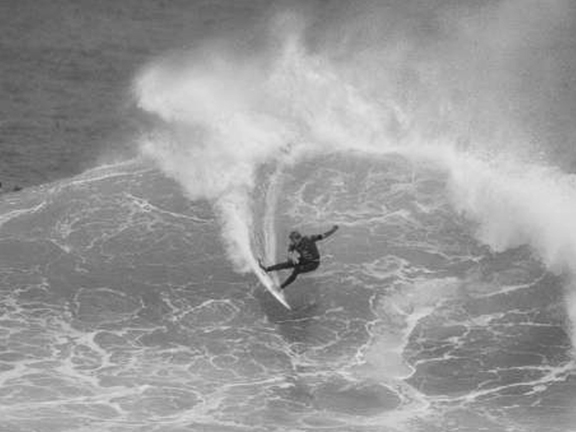
John John Florence Contemporary Rail Surfing |
|
US Blanks manufactures water blown Toluene Dilsocyanate (TDI) based
polyester polyurethane foam blanks. They believe this process provides the best
physical properties of a blank required for a quality surfboard. The resulting
blanks feature maximum strength to weight ratio and a solid flex pattern
yielding the best performance qualities for a shaped blank. The quality,
stability, and consistency of TDI polyurethane blanks make them the preferred
choice of the majority of shapers and board builders. US Blanks continues to
fine tune their formulations to supply shapers with design specific molds, foam
densities, and stringers that maximize strength to weight ratio, flex, and ease
of shaping.
Polyurethane blanks are manufactured in multiple densities. US Blanks offers six design specific densities. Orange or Competition weight for ultra light shortboards, Red or performance weight for versatile shortboards, light step ups and semi guns, Blue or stock weight for mid lengths, eggs, XXL guns, and light longboards, Green or cruiser weight for most long boards and heavier XXL guns, Classic weight for old school or traditional long boards, and Tow in weight for tow boards. Shapers will recommend and use any of these foam densities for their designs based on the performance requirements of their shapes and preferences of the surfers riding their shapes. The primary density of a polyurethane blank is a constant. The density of a finished shaped blank varies by how deep the shape is relative to the skin of the blank. The density of skin and core varies from mold compaction and skin to core ratio. The skin of polyurethane blanks is moderately denser than the core of a blank. To maximize the physical properties specifically the strength of the deck of surfboards shapers employ a technique known as close tolerance shaping. The idea is to have the deck of a shaped blank as close as possible to the skin or deck of the blank. When the deck rocker of master plugs is a close match to the deck rocker of a shaper's design rocker adjustments or custom rockers are not required to maximize the strength of a surfboard's deck. When natural deck rocker of a blank is not a close match custom rockers are employed to create a blank that matches the shaped blank's deck rocker to maximize physical strength of a board's deck. Stringer selection is an important and major factor for custom rockers. A stringer must be wide enough to hold the rocker adjustment of a blank. Significant rocker adjustments from the natural rocker of a design specific mold require a wider stringer to maintain the adjustments. Moderate or minimum rocker adjustments will hold with thinner stringers. The width of stringers is also a significant design factor. Shaped blanks with wider stringers will have a stiffer flex and spring back feature. Narrower stringers will have a more flexible flex and spring back feature. Perfromance requirements of different designs determine appropriate stringer width. Polyurethane foam is stable and consistent. Polyurethane core surfboards offer consistent, predictable, and controlled performance. Their performance and feel make them the preferred construction option for surfers, shapers, and board builders. The variety of blank densities, rockers, and stringers coordinated with glassing schedules allows shapers and board builders to design and create boards that maximize performance for any design or style of surfing in virtually any waves and conditions. |
|
EPS / EPOXY SURFBOARD PERFROMANCE
Prior to 2005 and the closure of Clark Foam, EPS / Epoxy construction technology had a minor role in custom and high performance surfboard shaping and manufacturing. Production boards and a few forward and progressive thinking custom shapers being the exception. The abrupt closure of Clark Foam in December 2005 and the rapidly increasing use of CNC shaping changed that and opened the door to EPS / Epoxy technology. Alternative blanks and shaped blank cores for custom surfboards were sought after by shapers and surfboard manufacturers world wide. The demand for quality and easily shaped blanks led to significant improvements in EPS foam particularly cell fusion. The proliferation of shaping machines and design software solved technical problems shaping EPS blanks. And improvements in the properties of Epoxy resins, their clarity and ease of use, made epoxy resins practical for manufacturing custom boards. These factors made EPS / Epoxy technology and boards an integral part of the custom and high performance surfboard industry. Epoxy surfboards is a somewhat vague description and doesn't completely describe EPS / Epoxy construction technology. To be specific an EPS / Epoxy surfboard is a composite of EPS foam, fiberglass fabric, and epoxy resin. EPS foam is a an ultra light low density foam and a useful blank option for light weight responsive boards in small waves and underpowered conditions. Light, buoyant, responsive, and sensitive EPS foam core boards are great for progressive performance surfing in such waves and conditions. They are buoyant, sit high on the water, and thus have less drag in waves of marginal power. These features create acceleration, speed, and maneuverability and makes them a good option for small wave boards. EPS / Epoxy surfboards are a popular construction technology option for several designs and functions. They are light, buoyant, and durable. They perform well for experienced surfers in small waves that lack power and energy. And they are durable and functional for entry level and novice surfers. With the same glassing schedule (the types of fiberglass fabrics, the fabrics's weights, and how many layers of fabrics are used glassing the top and bottom of a board) EPS / Epoxy boards will be lighter, stronger and more durable than PU / PE construction. Variations in the weight and weave of fiberglass fabrics and their schedule can render either construction technology lighter or heavier and stronger or weaker. Epoxy construction boards tend to be springy and lively in small waves and marginal conditions due to their light weight, firm flex pattern and low density EPS foam cores. However, this springy and lively feel can be less predictable and consistent underfoot, and can create a disengaged feeling in waves with more power and energy and in choppy or bumpy conditions. EPS / Epoxy boards are generally surfed in and can excel in small and marginal waves due to their buoyancy and lively nature. An EPS / Epoxy composite has a firm flex pattern allowing the boards to flex and spring back when weighting and unweighting through turns and maneuvers. Generally, if you ride the same design with different construction technologies you will find EPS / Epoxy boards will amplify performance in small, marginally powered waves and clean conditions and be unpredictable and disengaged in heavy water, bigger waves, and choppy or bumpy conditions. PU / PE boards will maximize performance with their consistent and predictable performance features in waves with more energy and power and in diverse conditions. |
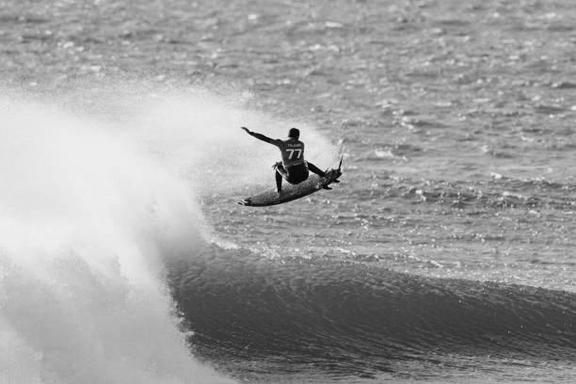
Felipe Toledo Progressive Small Wave Surfing |
| The downside of EPS / Epoxy boards due to their lightweight and buoyant nature is their lack of predictability, consistency, and control in heavy water and larger surf and choppy, windy, and rip tide affected conditions. In these conditions they tend to chatter and bounce around and it's difficult to control the rails and ultimately control the board. It can be difficult to control a rail through maneuvers and consequently a board can feel disengaged from a wave and the water. |
| |
|
|
SUMMARY
PU / PE boards sit well in the water and are engaged in waves. They are predictable and consistent and easy to control through turns and maneuvers. PU / PE boards accelerate, project, and sustain speed. They maintain these perfromance features, are universally functional, and excel across the entire spectrum of wave sizes and conditions. PU / PE boards have a great feel underfoot. EPS / Epoxy boards sit high on the water. They are light and buoyant. EPS / Epoxy boards are quick to accelerate, gain speed, and perform maneuvers in underpowered waves. They excel in small waves, in marginally powered waves, and in clean conditions. EPS / Epoxy boards are very durable. Ultimately, the choice between PU / PE boards and EPS / Epoxy boards depends on a surfer's personal preferences, their skill level, and the conditions they surf. As waves and conditions vary the choice of construction technology and manufacturing schedules can vary. A surfer may prefer PU / PE boards in many waves and conditions and EPS / Epoxy boards in other waves and conditions. |
| |
|
| |
< top of page > |
| POLYURETHANE and EPS BLANKS | |
| |
|
| |
March 28, 2023 |
| |
|
|
POLYURETHANE FOAM and BLANK HISTORY
In the 1930s Central and South American balsa wood became a popular material for shaped blanks or the core of surfboards. The end of World War II opened up new possibilities in surfboard construction, technology, and ultimately design. New materials became available through advances in technology during the war. Wartime chemistry and imaginative surfboard shapers and manufacturers pioneered surfing's progression into polyurethane foam shaped blank cores. Polyurethanes trace their origins back to 1937, when a German chemist, Friedrich Bayer, developed the earliest prototype of Polyurethane fibres known as Perlon U. Dana Point surfer and board builder Whitey Harrison successfully made a polyurethane foam blank in his barn in 1955. Balsa wood remained the primary material for the core or shaped blank of surfboards through the late '50s and remained relevant while shapers and board builders experimented with polyurethane foam. Shapers invested a great amount of time creating balsa blanks milling and gluing balsa planks into a suitable blank for shaping surfboards. In 1957, a resin salesman provided Hobie Alter a sample of polyurethane foam, a synthetic material developed during World War II and polyurethane foam was introduced to the commercial surfboard industry. Polyurethane foam was a material that allowed shapers to create a lighter, cheaper, less time consuming material for the core of surfboards. Unlike EPS foam which was extremely difficult to shape, polyurethane foam could be shaped with saws, electric planers, block planes, surforms, sand paper on sanding blocks, shaping screens, and other tools. And most importantly it bonded with polyester resin to form a high strength to weight composite instead of dissolving the way EPS foam did. Hobie Alter received credit in 1958 for introducing and promoting polyurethane foam boards to surfing. However, a full year before Hobie and Gordon Clark started developing their molded polyurethane surfboard blanks another Southern California shaper, Dave Sweet had already created a rideable polyurethane foam surfboard. In 1957 Hobie Alter and Grubby Clark were developing their version of a polyurethane foam blank unaware that Dave Sweet had already created a polyurethane blank and had shaped, glassed, and surfed the first polyurethane foam surfboards. Later all three agreed that they separately developed the polyurethane foam surfboard blank. Hobie Alter got credit for introducing polyurethane foam to the surfboard shaping and manufacturing industry and Dave Sweet was overlooked as the original pioneer of the polyurethane core surfboard. The Smithsonian Museum has a Dave Sweet board in their collection, acknowledging that he was the first to make a polyurethane foam surfboard blank and surfboard. He is correctly remembered as the father of the foam surfboard. In 1961, Hobie Alter and Gordon Clark agreed to split their interests with Hobie focusing on shaping and manufacturing surfboards and Grubby, as he was known, focusing on further developing polyurethane foam and molds to create polyurethane foam blanks. In just a few years, Clark Foam was dominating the market with exceptional surfboard blanks. At its peak, Clark Foam produced an estimated 90% of blanks sold in America and 60% of those sold worldwide. On December 5th 2005 the surfboard industry changed forever overnight when Gordon "Grubby" Clark shut down Clark Foam. The abrupt closing of Clark Foam shocked the surfboard shaping and manufacturing industry. Shapers and board builders scrambled for new suppliers of polyurethane foam. Just a year later, two former Clark executives, Kim Thress and Jeff Holtby launched US Blanks, a company that today is the gold standard of the market. As abruptly as Clark Foam shut down, US Blanks designed dozens of molds of various sizes for shortboards, fish, eggs, XXL guns, longboards, and SUPs. They also offered their polyurethane foam blanks in a variety densities from ultra light to tow density and a wide variety of wood and foam stringers. And just like Clark Foam, US Blanks offered custom rockers for diverse designs and most importantly for close tolerance shaping as polyurethane foam blanks are denser on their skin than deeper into their cores. US Blanks manufactures a water blown, TDI Polyurethane foam. Today polyurethane foam is still the most widely used core for surfboard production. Not only does US Blanks offer excellent polyurethane foam blanks filling the void left by the closure of Clark Foam they also offer molded and block cut high quality super fused EPS foam blanks in multiple densities with the same custom stringers and rocker features of their polyurethane foam blanks. During the immediate short term absence of the high quality polyurethane foam blanks and their reliable distribution shapers and board builders turned to alternative, new, and innovative blanks and materials. This set the stage for the relevance and growth of EPS / Epoxy surfboards. |
|
EPS FOAM and BLANK HISTORY
Expanded Polystyrene or EPS Foam is a versatile plastic polymer that dates to the 19th century. Commercial manufacturing of EPS dates to the 1930's. Scientists from BASF and Dow Chemical introduced "Styrofoam" to the US market for multiple applications including marine products. In the fall of 1950 two young Mission Beach Life Guards, John Blankenship and Bill McKusick built the first all EPS foam, fiberglass, and resin surfboard. They sealed the EPS foam core with white glue (with marginal success) to prevent the resin they used from desolving the EPS core. Weighing less than ten pounds, they created quite a sensation among surfers at Windansea in La Jolla. They were aware that Bob Simmons had created a sandwich construction board with an EPS foam core earlier that year. Simmons' EPS foam core was sealed from the resin with a thin balsa wood veneer. In the summer of 1951 Don Okey heard of the use of epoxy resin in the aircraft industry. He obtained experimental epoxy resins from the Shell Oil Company and several catalysts and monomers from other manufacturers. With these he formulated an epoxy resin and proceeded to make the first EPS foam surfboard glassed with epoxy resin. Commercially, EPS foam blanks have been used in surfboard construction since the 1970's. Prior to 2005 EPS foam blanks and EPS / Epoxy construction technology had a minor role in custom and high performance surfboard shaping and manufacturing. Production boards and a few forward and progressive thinking custom shapers being the exception. The closure of Clark Foam and the rapidly increasing use of CNC shaping ushered in a new era for EPS foam blanks and EPS / Epoxy composite technology. Alternative blanks and shaped blank cores for custom surfboards were sought after by shapers and manufacturers world wide. EPS foam gained popularity with advancements in their technology that made working with EPS foam easier. This demand for premium quality and easily shaped blanks led to significant improvements in EPS foam particularly cell fusion. The proliferation of shaping machines and design software solved considerable technical problems shaping EPS blanks. And improvements in the properties of Epoxy resins, their clarity and ease of use, made epoxy resins practical for manufacturing custom boards. These factors made EPS / Epoxy technology and boards an integral part of the custom and high performance surfboard industry. |
| |
|
| |
< top of page > |
| |
LITERS as a DESIGN VARIABLE |
| |
|
| |
January 23, 2023 |
| |
|
| |
A liter is a unit of volume. In surfboard design liters are a useful
component that defines the volume of a board. Historically, a surfboard's
dimensions - length, width, and thickness - have been the primary elements to
describe the size of a board. Although these primary dimensions offer
considerable insight into the performance of a surfboard they don't accurately
measure the volume of a board. It's critically important to remember that the
major elements of design - rockers, profiles and foils, outlines, rails, bottom
contours, and fins - are the primary determining factors in the performance of
a surfboard. Volume measured in liters in surfboard design offers an additional
and very useful point of reference to a design.
Prior to the use of CNC software in surfboard design, volume was quite difficult to calculate. Surfboard design software accurately calculates the volume of a board. Considered with length, width, thickness, the distribution of volume, the foil, the other primary elements of design, and the surface geometry of a board, the volume of a design measured in liters helps shapers and surfers have a clear idea of how well tuned a board is for any surfer. |
| |
|
| |
< top of page > |
| |
|
| |
SURFBOARD RAIL ANATOMY |
| |
|
| |
RAIL CONFIGURATIONS, FEATURES and FOILS |
| |
|
| |
June 21, 2022 |
| |
|
| |
OVERVIEW
Rails are a critical component of every board. The configuration, volume, and features of rails - the profile, apex, tuck and edge, and volume determine how rails perform. The performance of a well designed rail for surfers, waves, and conditions offers acceleration, projection, planning speed, maneuverability, and control. Nuanced variations in rail features provides maximum performance features for various surfboard designs and classes. RAIL CONFIGURATIONS FEATURES Rail configuration is significant not only for it's features and the rail's performance, but also for and how seamless the rails perform in sync with the other variables of a board's design. |
| |
|
| |
 |
| |
|
| |
Full Rail Profile |
| |
|
| |
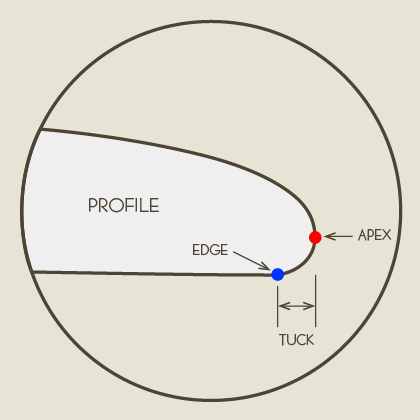 |
| |
|
| |
Rail Profile Zoomed in with Configuration Features |
| |
|
| |
PROFILE The profile of a rail is defined by the curve connecting the top
and bottom of a board. The apex or furthest point from the center of the board
in this curve determines the type or class of rail. Rail profiles vary from
nose to tail. The apex is foiled from the nose and entry, through the wide
point to the tail. Profiles are neutral in the nose, entry, and wide point and
develops a tucked corner and edge as it transitions from wide point to tail.
It's important to note that as a rail profile transitions or foils from nose to
tail the rail profile curve on the deck side of the rails maintains it's
profile and curve. The rail profile curve from the apex to the bottom changes
to develop the tuck and edge common and essential to rail and ultimately board
performance. The apex of rails in most surfboard classes and designs is at or
below center of a boards thickness. Common rail profiles as defined by their
apexes are a 50 / 50 rail profile, a 60 / 40 rail profile, and some lower rail
profiles depending on the performance requirements of a board. Prior to the
shortboard revolution of 1966 to 1969, classic LBs featured a neutral 50 / 50
rail profile. Early shortboards featured the same neutral rail profile. This
rail configuration featured stability and control, but failed to offer much
acceleration, projection, planning speed, or maneuverability. The shortboard
revolution introduced a lower apex to rails. The down rail profile creates
notably more lift and less drag providing more acceleration, projection,
planning speed, and maneuverability with excellent stability, predictability,
and control. The development of the down rail profile by Mike Hynson improved
surfboard performance dramatically and was a quantum leap forward in surfboard
design.
APEX The apex of a rail is the point on a rail where the profile transitions from the top or deck to the bottom of a board. It is the furthest point of a rail from the center of a board. The apex is higher on full boxy rails and lower on crowned rails. The apex of a rail remains constant in proportion to the rail foil from nose to tail to maintain uninterrupted laminar flow. The rail foil mimics and is in sync with a board's profile foil creating acceleration and control. TUCK and EDGE Tuck and edge are features that define the rail profile from the apex of the rail to the bottom of a board from nose to tail. Tuck is how far this curve goes into the bottom of the board. Generally, there is more tuck in the nose, entry, and wide point. Tuck decreases from wide point to tail. Edge is the transition from tucked rail to the bottom of a board. Edge is generally non existent in the nose, entry, and wide point. It starts to develop at the wide point and develops notably as the rail nears the tail. VOLUME Rail volume is a feature that with the other features of a rail determines how a rail enters, holds, and releases the water in the face of a wave when turning and planning. Higher volume rails require more force from a surfer for rails to enter and release water and perform maneuvers. Conversely, lower volume rails require less force from a surfer for rails to enter and release water and perform maneuvers. Too much rail volume and a board will keep a board high on the water, ok for speed, but lacking control on rail. Too little volume and a board will sit low in the water and when on rail will not have the buoyancy necessary to accelerate and project after engaging and releasing the rail. Correct rail volume with an appropriate profile well foiled from nose to tail, will engage the rail with stability and control and release the rail to accelerate and project out of turns and sustain and maintain speed through turns and maneuvers. DOWN RAILS All contemporary surfboard classes and designs feature a down rail profile with the exception of classic LBs and some retro designs. Rail profiles lower than a 50 / 50 profile are a down rail profile. The low apex of a down rail profile creates lift and reduces drag creating acceleration, projection, speed, and maneuverability. The deck side curves created by the rail's low apex hold the rail and board securely in the face of a wave with stability, predictability, and control through turns, speeding down the line rail to rail, or in trim. The bottom side of the rail with it's transition from soft moderate tuck with no edge in the nose, entry, and wide point to the reduced tuck and developing edge in the tail releases the rail. Specific down rail design features - profile, apex, tuck and edge, and volume - will vary and are tuned for surfer, board design, and wave size, quality, and conditions. PRIMARY RAIL PROFILES BOXY RAILS Fuller boxier rails are generally for boards that require more rail volume. Shorter boards for marginal waves, boards for heavy footed or bigger surfers, and boards requiring more stability. Note the higher apex and slightly deeper tuck of the boxy profile. |
| |
|
| |
 |
| |
|
| |
CROWNED RAILS Crowned, domed, or tapered rails are generally for boards that require less rail volume. Performance shortboards for quality waves, Step ups, Semi guns, boards for light footed or smaller surfers, and boards requiring maximum control. Note the lower apex and slightly shallower tuck of the crowned profile. |
| |
|
| |
 |
| |
|
| |
DESIGN SPECIFIC RAIL FEATURES
SHORTBOARD, STEP DOWN, and STEP UP RAILS Shortboard, step down, and step up rail profiles range from boxy to crowned. Rail volume is tuned to surfers and waves based on theories of volume and displacement. Tuck in the nose, entry, and wide point is neutral with no edge. Tuck from wide point to tail decreases notably to no tuck and hard edge in the tail. The neutral entry and wide point profile foils to minimum tuck and hard edge well forward from the tail on shortboards and step ups to maximize release and lift. The nuanced, balanced, and integrated rail profile, rail foil, and tuck and edge of shortboards and step ups fit naturally and comfortably in critical sections of waves creating acceleration, projection, planning speed, and maneuverability. SEMI GUN RAILS Semi Gun rail profiles are moderately crowned or low volume box. Rail volume is tuned to surfers and waves based on theories of volume and displacement. Tuck in the nose, entry, and wide point is neutral with no edge. Tuck from wide point to tail decreases gradually to minimum tuck and soft edge in the tail. The neutral entry and wide point rail profile foils to minimum tuck and soft edge at the tail in semi guns for release and control creating lift, acceleration, projection, planning speed, and maneuverability. XXL GUN RAILS XXL Guns feature a crowned deck or a flat deck for increased paddling power and stability in XXL waves and heavy water and a low chiseled rail profile and foil for performance and control. XXL Gun rails are tuned to surfer and XXL and heavy water waves. The rail profile is constant from wide point to tail, but the volume and thickness of the rail foils with the the profile foil of the board. Although crowned and tapered the rails of a gun must have significant volume to accomodate the speed and power in XXL waves and heavy water. The rail must support the forces of the wave and the surfer to control and maintain speed dropping into critical XXL waves and carving long turns on rail. Tuck in the nose, entry, and wide point is neutral with no edge. Tuck from wide point to tail decreases gradually to minimum tuck and soft edge in the tail. From wide point to tail the bottom of the rail profile transitions from a neutral tucked profile to a moderately tucked soft edge. At the fin the rail has some tuck to maintain maximum control and stability. The neutral entry and wide point rail foil with minimum tuck and soft edge in the tail is designed to control the speed and power of XXL waves and heavy water. MID LENGTH and EGG RAILS Mid Length and Egg rails are borrowed from the modern shortboard. The notable and substantial volume of Mid Length and Egg designs from their length, width, and thickness requires the rail profile to be a lower moderately thin boxy profile or lower crowned rail profile. The profile is round and neutral through the nose, entry, and widepoint allowing the rail to engage the face of waves as a board rolls onto the rail. The round, neutral rails in the entry and wide point provide easy transitions from rail to rail in critical tight sections of waves. Rail volume is tuned to surfers and waves. From the wide point to the tail the rail profile remains the same on the deck, but below the apex develops a tucked edge. At the fins the rail has minimum tuck and a moderately hard edge. The rail foil provides control and release creating acceleration, projection, planning speed, and manuverability. Mid Length and Egg rail profiles are sublime foils offering performance, planning speed, control, and stability. CONTEMPORARY LB RAILS Contemporary LB rails mimic shortboard, step up,semi gun, and mid length and egg rails. Contemporary LB rails feature the same sublime foils as mid length and eggs for performance generating acceleration, planning speed, control, and stability. Profiles range from full box to thin crown. Volume is tuned to surfers and waves. Rail volume also considers the size, technique, and style of the surfer and the dimensions and ultimately high volume of the modern contemporary LB. Tuck in the nose, entry, and wide point is neutral with no edge. Tuck from wide point to tail decreases to minimum tuck and soft edge in the tail. Like the rails on almost all designs and classes from shortboards to contemporary LBs these rail feature provide control and release creating acceleration, projection, planning speed, and manuverability. CLASSIC LB RAILS Classic LB rails are neutral from nose to tail. The profiles vary from 40 / 60, 50 / 50, to 60 / 40. The length, width, and ultimately high volume of a classic longboard, combined with the size, technique of the surfer, and deck design determine the volume of the rail. Rails tuck into the bottom from the apex from nose to tail. Tuck decreases slightly from wide point to tail. Classic LB rails have no edge. The neutral rails and apex nose to tail with with tuck and no edge are an essential feature of the glide, trim, and nose riding performance features of Classic LBs. RAIL PROFILE FOILS NOSE TO TAIL Rail profiles transition or foil from nose to tail to create a rail that engages the water in a wave for stability and control, creates lift to maximize performance, and releases water from the board in the tail to eliminate drag and promote acceleration, projection, planning speed, and maneuverability. The neutral rail profile in entry and wide point features a seamless transition of the curve of the rail from the top to the bottom of the board. The curve of the rail meets the bottom of the board at one single point creating a seamless profile. This transition from the apex of the rail to the bottom of the board promotes notable lift from the bottom and maximum rail control. The reduced tuck and developing edge from the wide point to tail produce a cornered transition from the apex of the rail to the bottom of the board. The bottom and curve of the rail intersect at one point creating a cornered profile that promotes more lift than the lift at entry and wide point and maintains stability and control. Although reduced significantly the tuck nearing the tail continues to maintain stability and control. A soft or hard edge with little or no tuck in the tail releases water from the rail. This release is an essential performance feature reducing drag and promoting acceleration, projection, planning speed, and maneuverability. The nuanced nature of the transitions or foil nose to tail in rail profiles are essential to all performance features for all surfboard designs and classes. Rail profiles foil from neutral nose tucked with no edge, to wide point with hints of nuanced tuck and no edge, to tail with minimum tuck and maximum edge. The foil from neutral entry to firm tail varies by a board's design and range of conditions. Boards for smaller or marginal waves feature less tuck and more edge from wide point to the tail. Conversely, boards for critical, powerful, hollower, or bigger waves feature more tuck and less edge from wide point to tail. Rail profile foils will vary depending on a board's design. Neutral nose, entry, and wide point is common to nearly every design and surfboard class. Tuck and edge from wide point to tail varies notably from small and moderate wave designs to XXL wave designs. Tuck and edge vary across the entire range of designs and classes from performance shortboards to mid length fun boards to cruising LBs. DESIGN SPECIFIC RAIL PROFILE FOILS SHORTBOARDS, STEP DOWNS, and STEP UPS Rail foil at nose, wide point, and tail designed to maximize performance features - acceleration, projection, and speed through turns, planning speed, maneuverability, predictability, control, and stability. The thinner neutral rail in entry and wide point allows the rail to engage the face of the wave. The developing tucked edge from wide point to tail creates lift. The tucked machined edge in the tail releases the rail. Note the apex and tuck in the nose, wide point, and tail. |
| |
|
| |
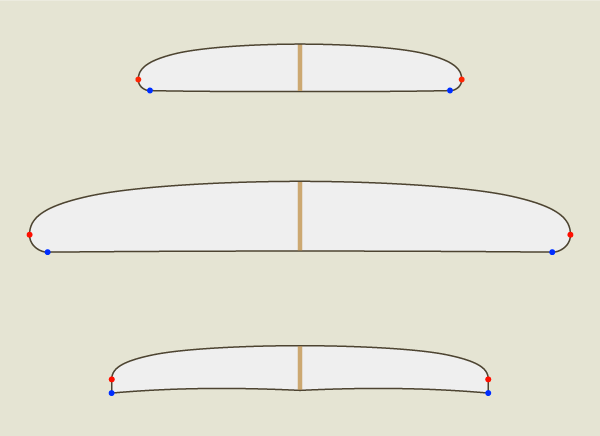 |
| |
|
| |
SEMI GUNS Rail foil at nose, wide point, & tail featuring hidden foam on the deck side of the rail profile for paddling with a low apex for performance and control. Note the apex and tuck in the nose, wide point, and tail. |
| |
|
| |
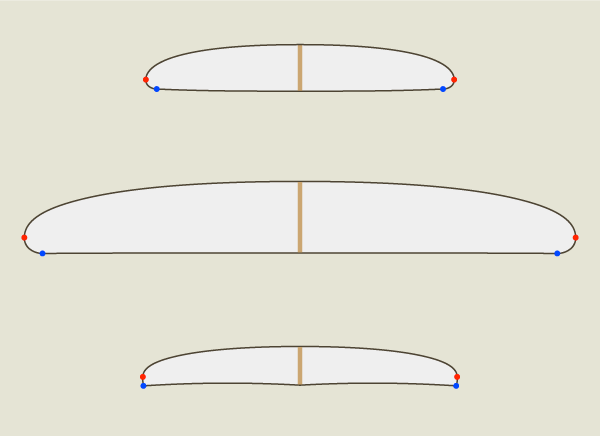 |
| |
|
| |
XXL GUNS Rail profile at nose, wide point, & tail featuring a flat deck for paddle power and stability and low chiseled rail for performance and control. Note the apex and tuck in the nose, wide point, and tail. |
| |
|
| |
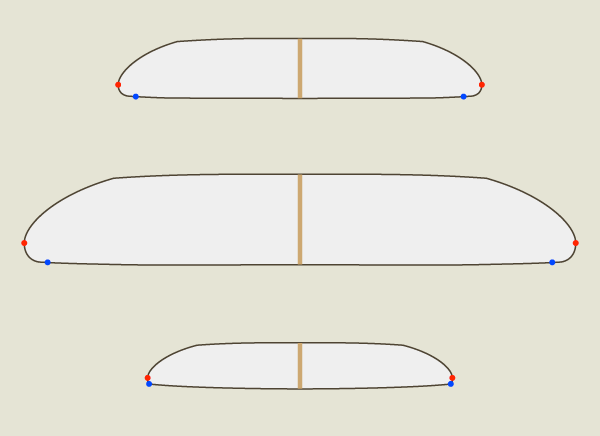 |
| |
|
| |
MID LENGTHS and EGGS Rail profile at nose, wide point, & tail featuring sublime foils for acceleration, projection, maneuverability, turning performance, planning speed, control, and stability. Note the apex and tuck in the nose, wide point, and tail. |
| |
|
| |
 |
| |
|
| |
CONTEMPORARY LBs Rail profile at nose, wide point, & tail featuring the same sublime foils as the mid lengths and eggs for acceleration,projection, maneuverability, turning performance, planning speed, control, and stability. Note the apex and tuck in the nose, wide point, and tail. |
| |
|
| |
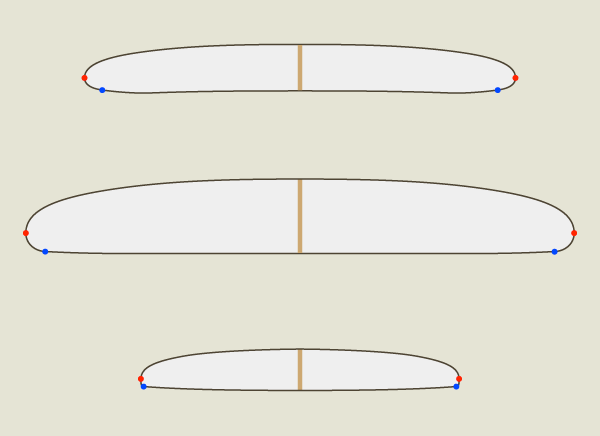 |
| |
|
| |
CLASSIC LBs Rail profile at nose, wide point, & tail featuring classic 40 / 60 profile nose, 50 / 50 profile wide point, and 60 / 40 profile tail. The neutral rail with no tucked edge holds the Classic LB firmly in the face of a wave - a key design feature for nose riding. Note the apex and tuck in the nose, wide point, and tail. |
| |
|
| |
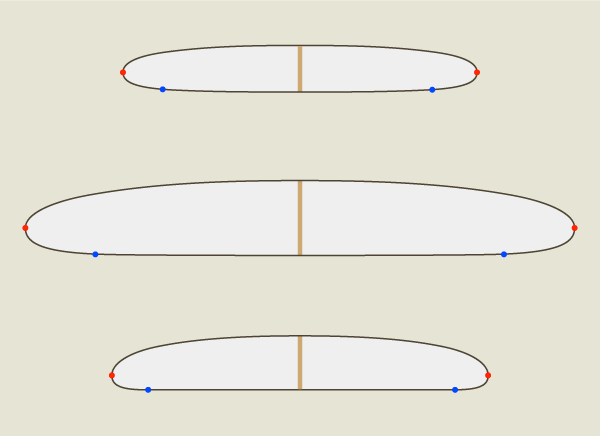
|
| |
|
| |
LINKS
Theory of Volume Theory of Displacement Tuning and Detuning Rails |
| |
|
| |
< top of page > |
| |
SURFBOARD FIN ANATOMY |
| |
|
| |
FIN HISTORY, CONFIGURATIONS, FEATURES, FOILS and CONSTRUCTION |
| |
|
| |
June 12, 2022 |
| |
|
| |
FIN HISTORY
Surfboard fins date to the mid 1930s. In 1935 Tom Blake attached the first known fin to a surfboard. After surfing with a fin or skeg as he referred to it for the first time Blake said, "When I first paddled out the board felt like it was much easier to keep in a straight line. I thought I might be imagining it. My first wave revealed the truth. Never before had I experienced such control and stability. It was remarkable the control you had over the board with this little skeg. I knew from that moment it was a success." The introduction of a fin on a surfboard changed surfing and surfboard design forever. In the 1950s innovative surfboard manufactures developed ever more functional solid fiberglass fins. In the 1960s Mike Hynson, Skip Frye, and Donald Takayama developed progressive longboard fins. In 1967 George Greenough introduced the high aspect ratio flex fin. In 1967 Tom Morey and in 1970 Bill Bahne designed and developed removable single fin systems. Credit to George Downing for creating an early removable fin box in 1951. In 1970 Steve Lis and Jeff Ching developed Twin Keel Fins for their Fish designs. In the mid 1970s Mark Richards and Reno Abellira developed Performance Twin Fins. In the 1980s Peter Ware and Glen Winton pioneered the first Quad configurations. Over the last 30 years Bill "Stretch" Riedel, Bruce McKee, and several other surfer shapers continued to develop the quad fin array. In 1981 Simon Anderson created the Thruster. In the 1990s FCS and Futures developed removable multi fin systems. In the 1990s fin manufacturers introduced RTM and G10 materials to fin construction. In the 1980s and 1990s Curtis Hesselgrave developed extremely progressive and performance enhancing foils including inside or vector foils. |
| |
|
| |
FIN CONFIGURATIONS | |
| |
|
|
| |
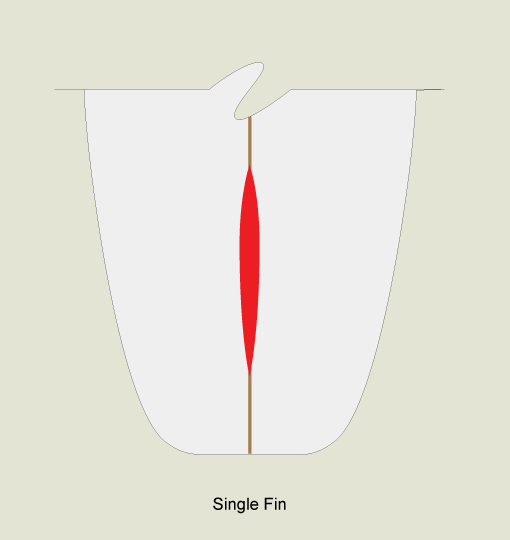
| |
| |
|
|
| |
SINGLE FINS Single fins were common to all surfboards with few exceptions from the first surfboards with fins to well into the shortboard revolution. Initially all single fins were "glassed on" until Tom Morey and Bill Bahne developed "fin boxes" to facilitate removable fins and fin placement forward and aft. Turning with a single fin is limited, meaning single fins are ideal for fast, straight shot surfing. Well foiled single fins of various configurations and depth offer a predictable, controlled, and stable feel to longboards, mid lengths, and classic or contemporary single fin shortboards. | |
| |
|
|
| |
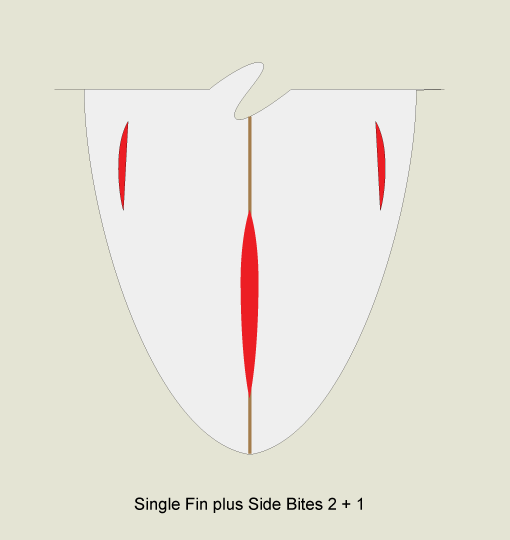
| |
| |
|
|
| |
2 + 1 FINS The 2 + 1 fin configurations feature a glassed on or removable box single fin lined up in the center of a surfboard with two regular thruster rail fin boxes near both rails. Center fins feature a symmetrical foil. Center boxes are 8.5" or 10.5" long allowing the fin to to be set forward or aft to vary performance. The two rail fins or side bites feature flat or asymmetrical foils offering a board greater lift and control. The 2 + 1 is fin configuration is common to most contemporary longboard, mid length, and egg designs. | |
| |
|
|
| |

| |
| |
|
|
| |
TWIN FINS Twin fins are a two fin configuration. They offer speed and maneuverability primarily from eliminating a center fin from the reading. Twin fins have more surface area, are deeper, and have a wider base than quad and thruster fins. The extra surface area is the driving force for this fin configuration. Twin fins can feature a flat, inside, or asymmetrical foil. The various foils provide nuanced variations in performance. Twin fins are most common to shortboards, particularly in smaller or moderate sized waves for their acceleration and speed, although they can be functional on all surfboard designs. | |
| |
|
|
| |
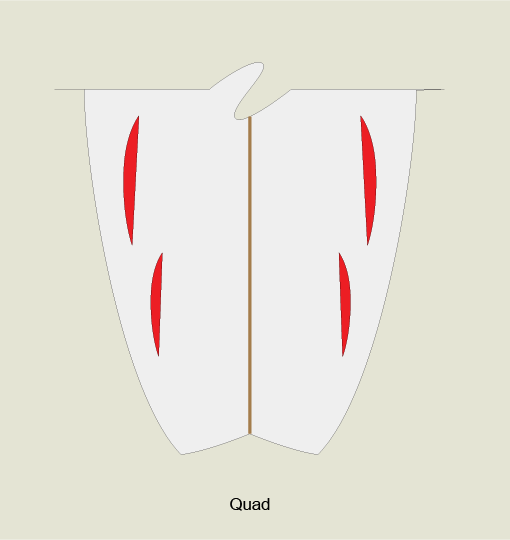
| |
| |
|
|
| |
QUADS Quad fin configurations offer acceleration, speed, and maneuverability in all conditions. The two fins, the leading fin and the trailing fin, configured near each other on each rail increase the surface area of fin on rail offering additional projection and power. The absence of a center fin notably reduces drag. The leading fins in a quad set are the same size as the rail fins in a thruster set and feature a flat foil. The trailing fins commonly have about 80% of the surface area, depth, and base of the leading fins and feature either a flat or 80 / 20 foil. Quads fins are common to boards surfed in hollow barrels and fast down the line waves on point, reef, and beach breaks. Quad fins are also very common and functional for XXL Guns in a variety of heavy water conditions. | |
| |
|
|
| |

| |
| |
|
|
| |
THRUSTERS The thruster fin configuration is the most common contemporary fin configuration. It is common and functional on nearly every class of surfboard. The front or rail fins are set angled near the center of the board at the nose. They typically feature a flat foiled inside surface (high pressure side when turning a board) to increase lift and projection. The center fin features a symmetrical foil to offer stability. | |
| |
|
| |
FIN DESIGN FEATURES | |
| |
|
|
| |
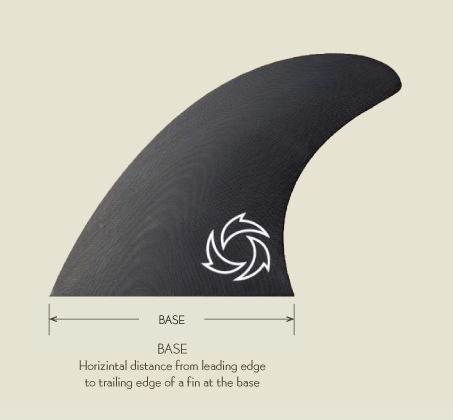
| |
| |
BASE The base is the length of the bottom of the fin. A longer base offers more lift and projection. A shorter base offers less lift and more maneuverability. | |
| |
|
|
| |
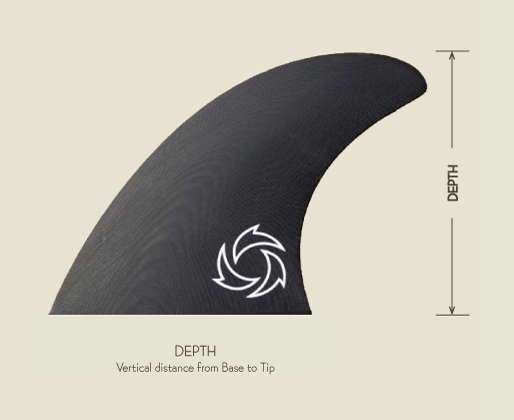
| |
| |
DEPTH The depth of a fin is the length of the fin from base to tip in a straight vertical line. Deeper fins offer more holding power - shallower fins less. Deeper fins provide longer turns and more projection - shallower fins provide a tighter turning radius and more maneuverability. | |
| |
|
|
| |
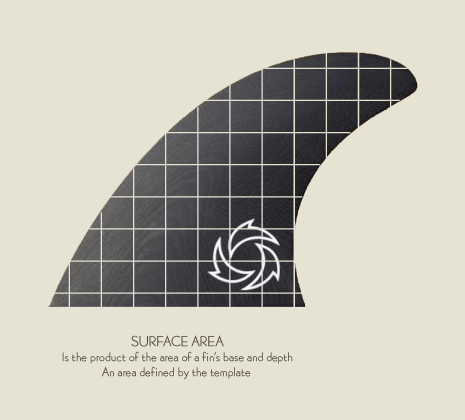
| |
| |
SURFACE AREA The surface area of a fin is a product of the geometry of a fin's template. It is the area of the surface of a fin. Surface area is a square measurement. A fin with more surface area will have more holding power and more projection. A fin with less surface area will have less holding power and less projection. Of note, more surface area increases drag and less surface area reduces drag. | |
| |
|
|
| |
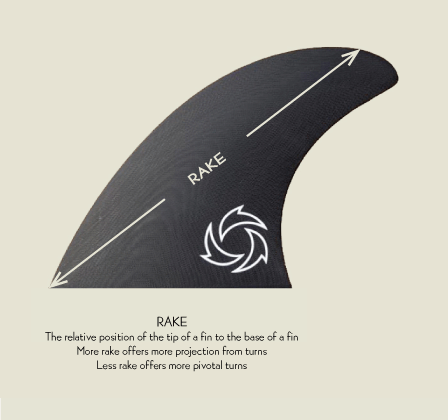
| |
| |
RAKE references the relative position of the tip of the fin to the base of the fin. A fin with more rake has the tip of the fin further aft relative to the base. A fin with less rake has the tip of the fin less aft relative to the base. More rake promotes more projection from turns. Less rake promotes more pivotal turns. | |
| |
|
|
| |
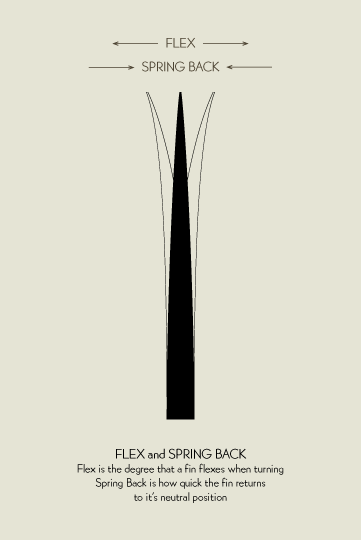
| |
| |
FLEX Fin flex and spring back is the degree that a fin flexes or bends side to side and springs back to it's neutral centered position when on rail or turning a board. The degree that a fin flexes and springs back are determined by the materials, foil, dimensions, and thickness of the fin and the surfer's technique. A well foiled fin will flex and spring back predictably and consistently providing surfer and board optimum performance. A thicker foil will generally have a stiffer flex pattern and quicker spring back. A thinner foil will have a softer flex pattern and slower spring back. A heavy footed surfer will generate more flex when on rail or turning a board. A light footed surfer will generate less flex. Flex and spring back function to help accelerate a board when engaging the rails and out of turns. Stiffer flex and spring back generate more acceleration and speed and great control in quality surf. Softer flex will generate acceleration and speed as well and can help generate those performance features in marginal surf. Flex that is too stiff won't offer much acceleration. Flex that is too soft offers no acceleration. | |
| |
|
|
| |
FIN PLACEMENT FEATURES | |
| |
|
|
| |

| |
| |
TOE is the angle that the rail fins are pointed towards the stringer or center of the board at the nose. Fins set more parallel to the stringer will offer longer radius turns and more projection. Fins set angled closer to the center of the board at the nose offer tighter turning radius and more maneuverability. Shapers can set the toe of fins with measurements at the leading and trailing edge of the fins relative to the stringer or center line of a board. Alternatively, toe can be set with a lengthy straight edge aligned with the position of the fin's trailing edge at its base and a position relative to the center of the nose of the board. | |
| |
|
|
| |
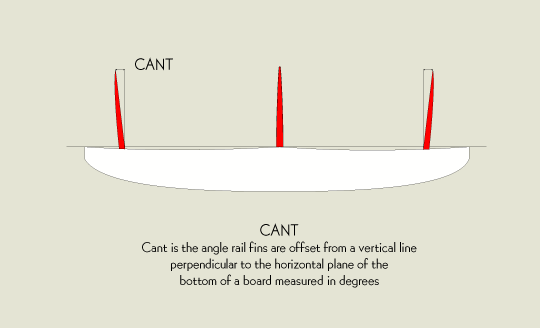
| |
| |
CANT is the degree of outward angle a rail fin is set in relation to the horizontal plane of the bottom of a board. Cant is measured in degrees. Fins set with less cant will offer more projection and less maneuverability. Conversely, fins set with more cant will offer less projection and more maneuverability. A cant of 6.5 degrees off a board's horizontal plane is common and offers a nuanced balance of projection and maneuverability. |
| |
|
| |
FIN FOILS
FOILS Surfboard fin foils are the shape and geometry of both sides of fins. Both sides of single fins and center fins in thruster configurations and the inside and outside surfaces of rail fins for twin fins, quads, thruster, and 2 x 1 configurations all have nuanced foils best suited for their design. Foils determine how water moves over the surface of fins. Foil configurations and geometry affect lift and drag and ultimately can be designed to yield particular and relevant performance features for fins. A functional and efficient fin will have different design features for different surfboard designs, surfers, and waves. Certain fin configurations and foils are ideal for small and moderate surf, marginal and clean conditions, bigger surf, or XXL surf. Some configurations and foils are universal and span several if not all designs, surfers, waves, and conditions. |
| |
|
| |

|
| |
|
| |
FIN FOIL CLASSES |
| |
|
| |

|
| |
|
| |
FLAT FOILS A flat foil features a flat inside surface and a convex outside surface. As a board moves through the water the flat inside surface is the high pressure side of the fin and the convex outside surface is the low pressure side of the fin. With the forward movement of a board through water the fins create lift providing the board with acceleration and speed. This performance feature distinctly separates boards with rail fins - twin fins, quads, and thrusters, from the neutral feeling of a single fin. The 2 x 1 fin configuration adds an element (feature) of lift and extra acceleration and speed to a single fin. A flat foil offers a balanced combination of projection, release and control across a wide spectrum of surfboards, surfers, waves, and conditions. The performance, stability, consistency, predictability, and reliability of flat foils make them the most common foil for twin fins, quads, and thrusters |
| |
|
| |

|
| |
|
| |
INSIDE FOILS An inside or concave foil features a concave inside surface and a convex outside surface. Inside foils are also know as "Vector" foils. The leading edge has a neutral asymmetrical foil. A concave surface over the same template will have more surface area than a flat foil. (Simple geometry.) The extra surface of an inside foil offers more lift. The extra lift is an asset in smaller, slower, flat faced waves at slower speeds. In better waves the extra surface area has more drag and can slow a board down particularly between turns. |
| |
|
| |

|
| |
|
| |
ASYMMETRICAL 80/20 FOILS An asymmetrical or 80/20 foil features the combined performance of a nearly flat foil on the high pressure side of the fin and a symmetrical foil on the low pressure side of the fin. This foil provides the lift and acceleration from the inside or high pressure side of the fin and the stability and the control of a convex symmetrical foil from the outside or low pressure side of the fin. The leading edge has a neutral asymmetrical foil. An 80/20 foil is common to trailers in quad configurations. This foil is also an intriguing option for twin fins. |
| |
|
| |

|
| |
|
| |
SYMMETRICAL 50/50 FOILS A symmetrical or 50/50 foil is used on all single fins and center fins. Both sides have a convex surface. Water flows equally on both sides creating a neutral, stable and controlled fin. A symmetrical foil is often used in quad trailers in quality or XXL waves for control and release in critical surfing. |
| |
|
| |
FIN CONSTRUCTION and MATERIALS
SOLID FIBERGLASS offer everything required for correct fin performance. They offer the fundamental performance features of acceleration, speed, projection, and maneuverability as well as firmly holding and releasing rail and fin. Solid fiberglass fins perform across the full spectrum of surfboard designs, surfers, and conditions. This material offers control and stability for powerful surfing in all conditions. They are built from solid fiberglass panels. Templates and foils will vary for designs and conditions. Solid fiberglass fins can have a consistent strong flex pattern and spring back with a thicker foil and a consistent softer flex and spring back with a thinner foil. The thicker stronger flex and spring back foil is well suited for and performs very well in powerful, quality, and bigger waves. The thinner softer flex and spring back foil performs well in less powerful, marginal, and smaller waves. G10 fins are made with a high strength epoxy and fiberglass material called G10. G10 material is made by compressing multiple layers of fiberglass and epoxy resin under heat and pressure. G10 fins are stronger and lighter than solid fiberglass and can be foiled thinner. Their flex pattern has solid and quick spring back providing extra projection and excellent release through turns or going rail to rail speeding down the line. RTM FINS or Resin Transfer Molded fins are made of fiberglass, polyester resin, and a hexcore honeycomb core. This material combination is designed to offer similar performance to solid fiberglass fins with less weight. Strategically placed fiberglass and carbon fiber reinforcements maintain a functional flex and spring back. RTM fins are the most flexible of common fin materials. The extra flex and softer spring back make an RTM fin an option in marginal conditions and moderate waves when the extra flex can add spring and acceleration to turns. |
| |
|
| |
LINKS
NVS Fin Guide - Fin Technology NVS G10 Fins True Ames Fin Guide - Fin Technology True Ames Fins Futures Fins |
| |
|
| |
< top of page > |
| |
THE ORIGIN of the SHORTBOARD REVOLUTION | |
| |
|
|
| |
THE MINI GUN and THE PLANNING HULL | |
| |
|
|
| |
June 3, 2022 | |
| |
|
| |
One of the many Golden Eras of surfing and surf culture and one of
only a few quantum changes in surfing, surfboard design and surf culture was
the Shortboard Revolution. This was not a change in style - but a notable
change in technique, maneuvers, where in a the wave maneuvers were performed,
and surfing increasingly more critical waves. These were the initial stages in
the evolution of the modern, contemporary high performance shortboard, and
every other contemporary design class. Longboard maneuvers and performance were
well into progressing from stylish turn, trim, nose ride, and stall to
performance oriented maneuvers of the same variety. Consider the classic styles
of David Nuuhiwa, Mike Hynson, Skip Frye, and Billy Hamilton and compare them
to the performance styles of Nat Young, Wayne Lynch, Bob McTavish, and Phil and
Jim Irons. One of the most notable moments and examples of high performance
longboard surfing was Nat Young's surfing at the 1966 World Championships at
Ocean Beach in San Diego. His combination of carving turns and sublime nose
riding - particularly the carving turns - set the stage for the modern
shortboard to emerge over the next few years. The major performance difference
between traditional longboarding and performance longboarding was breaking up
the long straight lines of trim, like a bird soaring and gliding on the updraft
of a wave or an ocean swell, into a series of seamless and flowing turns
combined with trim and nose riding, like a fish or sea mammal accelerating in
and around those same waves and open ocean swells. The logical direction and
first step for surfboard design to best facilitate this emerging performance
oriented surfing was to shorten boards, soon followed by evolving rockers,
profiles, outlines, bottom contours and rails. Surfing and surf culture found
itself at the doorstep of the shortboard revolution.
An emerging generation of surfers and shapers were energetically influenced by the most innovative and creative surfer shaper designers of that era, particularly Dick Brewer, Mike Diffenderfer, George Greenough, and Bob McTavish. This iconic group of surfer shapers with their open minds and their passion for evolutionary surfing and surfboard design created two primary and distinct design threads, the Mini Gun and the Planning Hull. Brewer and Diff's designs were classic early Mini Guns. McTavish and Greenough's designs were classic early planning Hulls. The historical significance of this era of evolutionary surfing and surfboard design is remarkable. The Shortboard Revolution changed surfing, surfboards, and surf culture forever. |
| |
|
| |
 |
| |
|
| |
Surfing a Mini Gun - Small Zicatela 1973 |
| |
|
| |
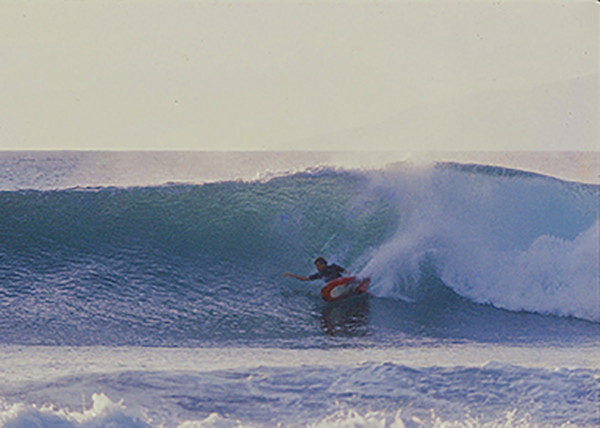 |
| |
|
| |
Surfing a Planning Hull - Honolua Bay 1967 |
| |
|
| |
Understanding these two designs and their history, The Mini Gun and The
Planning Hull are defined and best described by their design features, surface
geometry, and their performance.
THE DESIGNS' FEATURES THE MINI GUN Rocker: Notable rocker in the entry, flatter rocker mid board, and moderate tail rocker. Profile: Foiled with thinner nose and tail. Outline: Curves with pulled in nose and tail. Bottom contours: Tri plane entry and mid board (occassionally with shallow concave in the center plane of the tri plane mid board) to panel vee in the tail. Rails: Low "down rails" from nose to tail with hard machined edge in the tail. |
| |

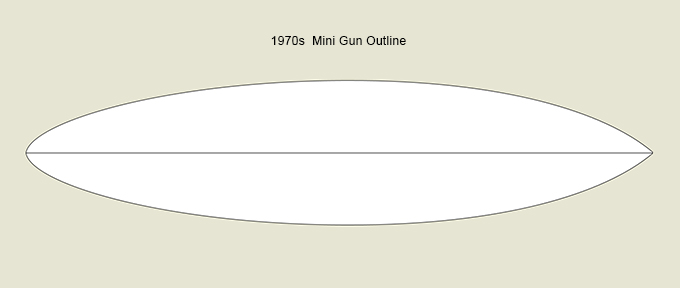
 |
| |
|
| |
THE PLANNING HULL Rocker: Low entry rocker and nearly flat rocker from mid board to tail. Profile: Foiled with full nose and thin tail. Outline: Parallel with full nose and tail. Bottom contours: Rolled (belly) entry to tri plane mid board to flat tail. Rails: Neutral nose and mid board to low in tail with short hard edge in the tail. |
| |
|
| |


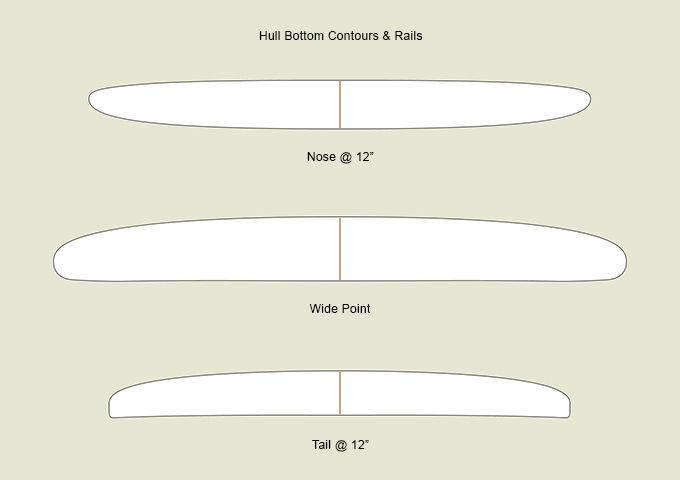 |
| |
|
| |
THE DESIGNS' PERFORMANCE
THE MINI GUN Carving turns and speedy trim, curved rocker and outlines fit exceptionally well in the critical part of a wave tapping into the power source of waves thus offering excellent acceleration and speed. Curved outlines promote release and offer multiple arcs and options for turns. Bottom contours create lift, reduce drag, and promote smooth rail to rail transitions. Low "down rail" rails generate and sustain speed. Hard edge in the tail releases water. |
| |
|
| |
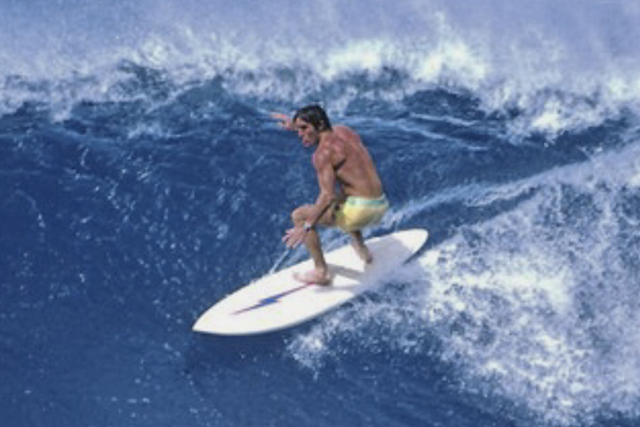 |
| |
|
| |
Surfing a Mini Gun |
| |
|
| |
THE PLANNING HULL Carving turns and speedy trim, straighter rocker fits moderately in the critical part of a wave taping into the power of waves offering moderate acceleration. Parallel outlines limit the arcs of turns. Bottom contours drag at low speed in marginal waves, but create lift and reduce drag in higher quality point and reef break waves. Soft and neutral rails provide good control, but struggle to develop and sustain speed. Hard edge in the tail releases water and helps the design achieve planning speed. |
| |
|
| |
 |
| |
|
| |
Surfing a Planning Hull |
| |
|
| |
SUMMARY
Historically, neither design took a break from relevance in surfing and surf culture. However, due to their superior performance across the whole spectrum of surfers, surf venues, and surf conditions the Mini Gun has been at the core of surfboard design since the late 60s. The design elements of the Mini Gun are fundamental to every contemporary surfboard design. Planning Hulls never disappeared from surfing and surf culture. However, with the superior and efficient performance of the Mini Gun and the shortboards that evolved from those original late 60s designs, the Planning Hull never captured the universal acceptance of surfers. Nonetheless, Planning Hull designs have been a constant in surfing and surf culture. In the current era of abundant alternative approaches to surfing and surfboard designs the Planning Hull has continued to evolve and has expanded it's following considerably. |
| |
|
| |
LINKS
1966 World Contest, Ocean Beach, San Diego 1966 World Contest Video |
| |
|
| |
< top of page > |
| |
FLAT DECKS |
| |
|
| |
July 3, 2019 |
| |
|
| |
Flat decks are an intriguing alternative to the classic crowned decks
common to contemporary shortboards. Prior to the development of the low vblume
- well rockered Glass Slippers of the early 90s, flat decks were very common.
Dick Brewer's shapes were the finest execution of this design. Their flat decks
were an essential feature in establishing a crisp profile or foil from nose to
tail.
The classic flat deck designs of the 70s and 80s featured primarily convex bottoms. The classic glass slipper featured concave bottoms. When we combine a flat deck with a concave bottom we're maximizing volume at and near the rails. This produced a relatively stiff board that didn't go rail to rail with ease. Concave bottoms contours and their performance features were here to stay so surfers and shapers gravitated to crowned decks of varying degree to facilitate rail to rail transitions which are essential and at the core of shortboard performance. A few years ago we were checking out a beautiful 9' 6" Dick Brewer XXL Gun with on Kauai with Dave Beck. The board had a flat deck and very crisp foil. It was a reminder of a great design feature. This board was inspiration to explore flat deck designs and introduce them as a design option for our boards.  |
| |
|
| |
9' 6" x 19 1/4" x 3" 2004 Dick Brewer XXL Gun |
| |
|
| |
What do flat decks bring to our design resources? The most obvious features
is the additional volume it brings to a shape when all other variables are held
constant. The deck is simply fuller side to side thus adding volume. See
illustration - black profile is flat deck - red profile is crown deck.

This image illustrates the extra volume in a flat deck compared to a crowned deck when their thickness is equal. The volume of the flat deck board is 32.5 Liters. The volume of the crowned deck board is 31.5 Liters. Flat decks also add an element of stability to a board. A deck with more volume towards the rail will not tip or roll side to side, or rail to rail, as easily as a classic crowned deck which is thicker at the stringer and thinner in the rails. How can we effectively integrate flat decks into contemporary designs ? That will vary by designs, venues, conditions, and surfers. When increased volume and stability are the primary design considerations simply redesigning the deck from crown to flat will yield a strong paddling, wave catching, stable, speed generating, and speed maintaining board. These performance features are an asset for many surfers and conditions - boards for larger surfers, older surfers, or surfers who are transitioning from mid range boards to short boards all of whom could benefit from more volume in their boards, boards for waves with marginal energy where extra volume will help generate and maintain speed and ultimately maneuverability, and boards for XL and XXL waves where extra volume and stability are essntial to paddling mobility, wave catching, and stability and flow in heavy water conditions. When performance is the primary design consideration, flat deck designs offer excellent and unique performance features in moderate and lower volume designs. Such flat deck boards have equal volume as crowned deck boards, but feature a thinner profile combined with equal rail volume. These design features yield a thinner board than an equal volume crowned deck board. These thinner flat deck boards are a very responsive and stable design. A flat deck board with equal volume to a crowned deck board has reduced thickness to achieve that same volume. Reducing flat deck volume to equal crown deck volume by thinning a board can yield a very well tuned high performance board. See illustration - black profile is flat deck - red profile is crown deck. 
This image illustrates the reduced thickness of a flat deck required to yield equal volume as a crowned deck. The volume of both boards is 31.5 Liters. The stable nature of a flat deck design offers yet another very functional design option. Reducing the volume even further can yield a design that combines the stable feel of a flat deck with the performance we associate with a crowned deck. See illustration - black profile is flat deck - red profile is crown deck. 
This image illustrates reducing the thickness of a flat deck board to yield the same rail volume as a crowned deck board. The volume of the flat deck board is 29.5 Liters. The volume of the crowned deck board is 31.5 Liters. The thickness of the flat deck board is 2 1/8". The thickness of the crowned deck board is 2 3/8". Flat deck designs offer unique performance features. The design is functional in all waves and conditions. They are particularly well suited for XXL waves and XXL guns. The extra volume of these designs are a great asset for the performance demands of heavy water and XXL waves and conditions. |
| |
|
| |
< top of page > |
| |
SINGLE & SINGLE to DOUBLE CONCAVES |
| |
|
| |
May 1, 2019 Updated June 6, 2024 |
| |
|
| |
Surfers are familiar with the common concave bottom contours in contemporary shortboards. The most common concave arrays are single concave and single to double concave. Concave shapes have more curve in the rail line than in the bottom. The curve in the rail rocker drops below the curve in the bottom rocker. This intriguing and nuanced juxtaposition of curves creates concaves. Concaves increase the surface are of the bottom of a board and amplify laminar flow. When tuned correctly these features generate lift, reduce drag, and amplify control. |
| |

|
| |
Note the RAIL ROCKER displayed in red drops below the BOTTOM ROCKER displayed in blue between the entry and the wide point to near the tail and rises above the bottom rocker near the nose and tail. This juxtapostion of the two curves creates the concave area in the bottom contours mid board and some vee behind the fins and in the nose. |
| |
|
| |
SINGLE CONCAVES
SINGLE CONCAVES offer the surfer acceleration, projection, speed, maneuverability and maximum control. Single concave designs are very powerful, fast, and loose. The simple clean rail to rail arc of a single concave offers maximum controlled lift to the rails. Water flows in a smooth arc from rail to rail in single concaves enabling powerful, stable, and predictable turns. The smooth rail to rail water flow enables maximum controlled power through turns and nuanced turning radii for a wide variety of turns in different waves. Single concaves offer maximum control and maneuverability in critical barreling waves. Surfers can turn with maximum load off the bottom contours and rails. Alternatively, a single concave will have a touch of double concave or vee in the last 4" to 5" of the tail. The short double concave or vee adds an extra element of release, stability, and control. The short double concave or vee are particularly functional on squash and swallow tail designs to promote easy rail to rail transitions. Moving the double concave feature forward in the bottom contours yields the classic single to double concave. |
| |
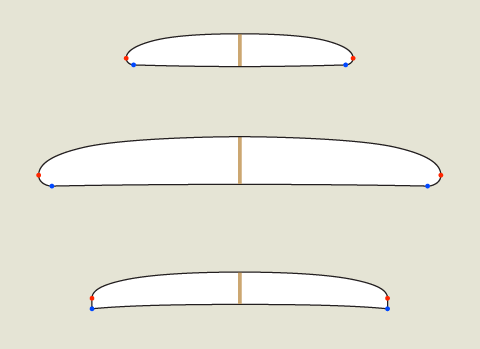
|
| |
SINGLE to DOUBLE CONCAVES
SINGLE to DOUBLE CONCAVES offer, in addition to acceleration, speed, projection, and maneuverability, an extra element of lift to a board. As water flows from rail the to the spine of the double concave it creates additional lift in the center of the board. The spine along the center of a double concave sustains the flow of water down the length of the bottom of a board maximizing laminar flow and directional stability through turns. The peak and the depth of the spine of a double concave can be moved forward or back and deeper or shallower to fine tune manuverability and control. A tuned double concave provides notable lift and reduces drag. The spine of the double concave and the performance features it offers make the design a great bottom contour option for the full spectrum of waves and conditions. |
| |

|
| |
Concaves are a radical design feature. By their nature they include conflicting forces. When well designed and balanced with other design variables and surfed with correct technique they generate lift and reduce drag. They offer acceleration, projection, planning speed, maneuverability, and control - all depending on nuanced and balanced design and surfer input. When poorly designed or not balanced with other design variables and surfed without correct technique they lack lift and will drag compromising all performance features. Concaves have different configurations, different depths, and different placement in a shape. Their radical nature allows surfers and shapers to tune performance by their configuration. A well designed concave array maximizes concaves' positive features - acceleration, projection, planning speed, maneuverability, and control. |
| |
|
| |
< top of page > |
| |
TUNING and DETUNING RAILS |
| |
|
| |
October 10, 2018 Updated September 30, 2023 |
| |
|
| Rail are configured of their profile, their apex, the mid point in the rail profile between the top and bottom of the board, and their tuck and edge, the bottom corner of the rail where the rail profile meets the bottom of the board. All features of a surfboard's rails are integrated to create a rail that best suits the purpose of the board's design.> |
| |
|
| |
 |
| |
|
| |
Full Rail Profile |
| |
|
| |
 |
| |
|
| |
Rail Profile Zoomed in with Configuration Features |
| |
|
|
When designing boards for a variety of conditions we can vary the tuck and
edge of the rail from the apex of the rail and from wide point to tail to fine
tune generating acceleration, projection, speed, and maneuverability and
control, the primary performance features of a surfboard. The further we tuck
the rail into the bottom of the board the more the board will sit down in the
water and conversely, the less we tuck the rail into the bottom of the board
the more the board will sit on top of the water. The more a board and rails sit
down in the water the more control a surfer will have performing maneuvers in
critical waves and barrels. We refer to this as "detuning" the rails. The less
a board and rails sit down in the water the more acceleration, projection,
planning speed, and maneuverability a board will have in small or marginal
conditions. We refer to this as "tuning" the rails. Basically we detune rails
to promote control in critical waves and barrels and tune rails to promote
performance in small and marginal waves.
The length a hard edge or a machined edge carries from the tail towards the wide point has a similar affect to the tuck of the rail. The shorter this edge, where the edge blends to a soft tuck from the tail towards the wide point, the lower the board will sit in the water and the more control the board will offer the surfer performing maneuvers in solid waves and quality conditions. The further this edge carries towards the wide point the higher the board will sit on the water and the more acceleration, projection, and speed it will generate in small waves and marginal conditions. |
| |
|
| |

|
| |
|
| |
This image illustrates no tuck and maximum edge. |
| |
 |
| |
|
| |
This image illustrates notable tuck and minimum edge. |
| |
|
| |
The distance a rail is tucked from the apex of the rail and the distance a
rail has a hard edge from the tail towards the wide point determines how a
rail's performance varies. Less tuck and longer edge offer more release. More
tuck and shorter edge offer more control.
Ultimately, the tuck and edge of rails allows us to fine tune control and performance in all our designs maximizing performance features for waves and conditions. Boards for small waves and marginal conditions will benefit from less tuck and more edge. Boards for all around conditions will benefit from a reasonable blend of tuck and edge. Boards for critical waves, barrels, heavy water, and big waves will benefit from more tuck and less edge. LINK Rail Anatomy 2012 & 2023 |
| |
|
| |
< top of page > |
| |
FOIL HISTORY | EVOLUTION and DEVOLUTION
November 10, 2020 Updated October 21, 2023 1966 to 1990 Shortboards date to the second half of the 1960s pioneered by George Greenough, Bob McTavish, Mike Diffenderfer, and Dick Brewer. Greenough's planning hull designs were the first shortboards and opened the door for decades of design evolution and performance surfing evolution. The core principle of Greenough's deigns were their foils. Correct distribution of volume creates a foil and ultimately acceleration, speed, and control. 
Mike Diffenderfer and Dick Brewer mini gun designs were the next step in the evolution of surfboard design. Diff and RB developed rockers and profiles that fit the most critical and powerful sections of waves enabling boards and surfers to tap into the abundant energy offered by waves. In the late 60's through the 70s and 80s their foils, profiles, rockers, outlines, and rails were the ultimate standard in surfboard design. Every design feature in their boards was foiled, balanced, and synchronized. 

Contemporary high performance shortboard designs date to the late 1980s and early 1990s. These designs were pioneered by the surfers of the Momentum Generation - Shane Dorian, Taylor Knox, Rob Machado, and Kelly Slater, and their Australian peers Taj Burrow and Shane Herring. Prior to that era shortboards were generally high volume designs featuring moderate length, full rails and outlines, and primarily convex bottom contours. The first generation of early contemporary performance shortboards are often refered to as Glass Slippers. They were extremely low volume designs featuring a very narrow outline, a very thin profile and foil, significant banana like rocker with accelerating tail and nose rocker, and deep concave arrays. Early versions of contemporary high performance shortboards - the Glass Slippers - were relatively long, extremely narrow, and extremely thin compared to today's shortboards. Common dimensions were 6' 0" to 6' 2" long x 17 3/4" to 18" wide x 1 7/8" to 2 1/8" thick. The basic distribution of volume was thin in tail, thin at the wide point, and even thinner in the nose. Typically, these profiles were 1/8" to 1/4" thinner 12" from the nose than 12" from the tail, and 1/16" to 1/8" thinner 24" from the nose than 24" from the tail. These designs featured banana like rocker and deep concaves. The relatively thicker back half of the profile and foil was designed to support the surfer with lift from surface area, deep concave array, and moderately foiled profile from wide point to tail. The nose was designed thinner to eliminate the effect of nose volume on the board's performance. These low volume designs remained the prototypical shortboard for 10 to 15 years despite their many limitations. Unfortunately, the Glass Slippers were radically over foiled. Fortunately, the core design features of the Glass Slipper have been the basis for the evolution of the contemporary shortboard. 
The evolution of high performance shortboards from 1990 to 2020 has been dramatic. 21st century surfing and surfboard design has produced progressive - maximum performance shortboards. It has been a truly practical, efficient, and versatile upgrade in surfboard design. This trend to maximum performance shortboards through efficient and versatile designs continues today and should arguably be a constant underlying theme in surfboard design. Design and performance evolved with nuanced rockers, profiles and foils, more surface area in outlines, efficient bottom contours, and tuned rails. 


EVOLUTION and DEVOLUTION of FOILS and PROFILES 1990 The Glass Slippers were a paradox of evolution and devolution of shortboard designs. The exciting performance features of these low volume designs overshadowed their lack of versatility both in various conditions and across the spectrum of surfer skill. This attraction to the potential for radical surfing combined with extreme rockers, extremely thin profiles and foils, and narrow outlines was like a lead weight on surfboard design and surfing performance for nearly two decades. Performance shortboards of this era were on average 6' 0" to 6' 4" long x 17 3/4" to 18 1/4" wide x 2" to 2 1/4" thick. The distribution of volume in the profile and foil was 1/8" to 1/4" thinner 12" from the nose than 12" from the tail, and 1/16" to 1/8" thinner 24" from the nose than 24" from the tail. 
1990 Foiled Profile 6' 2" x 17 3/4" x 2 1/16" - featuring original Glass Slipper high performance shortboard distribution of volume - extremely thin throughout - extreme entry and tail rocker - extremely low volume 2000 Boards began to get a little shorter, wider, and thicker and featured more nuanced rockers. Concave bottom contours were also moderated and tuned to improve overall performance while maintaining the lift factor they bring to these deigns. Performance shortboards of this era were on average 5' 10" to 6' 0" long x 18 1/2" to 19 1/4" wide x 2 1/4" to 2 3/8" thick. One feature remained the same and that was the distribution of volume in the profile and foil. The profiles and foils were still 1/8" to 1/4" thinner 12" from the nose than 12" from the tail, and 1/16" to 1/8" thinner 24" from the nose than 24" from the tail. These design changes initiated an era of expanded performance range for shortboard designs. Designs were notably more efficient and versatile than their original Glass Slipper predecessors. 
2000 Foiled Profile 6' 1" x 18 1/2" x 2 3/16" - featuring moderated and nuanced distribution of volume - thicker at widepoint - moderateely thicker nose and tail - moderated entry and tail rocker - moderately more volume 2010 Surfboard design continued trending to improved function and performance and more versatile surfboards. Twenty plus years of design, shaping, and surfing Glass Slipper inspired designs provided surfers and shapers with volumes of observations, feedback, and input to improve performance and versatility of contemporary shortboards compared to the first late 80s early 90s designs. Designs continued to improve performance and versatility across the whole spectrum of surf conditions. Efficient and practical design edits saw boards going marginally shorter, wider, and thicker compared to the previous 10 years. Common dimensions of this era are 5' 8" to 6' 0" long x 18 1/2" to 19 1/4" wide x 2 1/4" to 2 1/2" thick. One element of design that shifted notably is the distribution of volume in the profile and foil. As boards got shorter, more efficient and more versatile it was important to maintain volume or even add some volume to the core of the shape. Shapers started to hide foam in shapes corresponding to the area under a surfer's torso when paddling and stance when riding waves. Outlines also added hidden surface area with the same goal. The center of mass moved slightly forward with these volume and surface area adjustments. The other primary design elements - outlines, rails, and bottom contours, evolved in nuanced sync with rockers, profiles, and foils. 
2010 Foiled Profile 6' 0" x 18 3/4" x 2 5/16" - featuring more nuanced moderation in distribution of volume - thicker at widepoint - balanced thickness nose and tail - more moderated and nuanced entry and tail rocker - overall moderatley more volume 2020 The evolution of high performance shortboards from 2010 to 2020 was a truly practical, efficient, and versatile upgrade in surfboard design. The trend continues today and should arguably be a constant underlying theme in surfboard design. Performance shortboard designs added and shifted a bit more volume and surface area forward. Previously profiles and foils were 1/8" to 3/16" thinner 12" from the nose than 12" from the tail and 3/16" to 1/4" thinner 24" from the nose than 24" from the tail. Shifting volume forward made profiles and foils 1/8" to 3/16" thicker in the nose at 12" than at 24" from the tail and 3/16" to 1/4" thicker in the nose at 24" than at 24" from the tail. Adding and shifting volume and surface area forward was new to the basic all around shortboard, but not new to all designs. Step ups, semi guns, and XXL guns successfully featured hidden volume, equal and sometimes greater thickness in the nose than in the tail, and outlines with the widepoint and surface area shifted forward. When applied to contemporary shortboards this forward shift in the distribution of volume and surface area creates a better more efficient foil thus generating more lift, reducing drag and consequently providing more acceleration and speed. Lift reduces drag, reduction in drag increases acceleration and speed. 
2020 Foiled Profile 5' 11" x 19" x 2 3/8" - featuring volume shifted forward - moderate thickness throughout - thicker nose relative to tail - moderate entry rocker and lower tail rocker - notably more volume - versatile and efficient design - generates and maintains speed - accelerates on demand 2024 Evolution of shortboard design is a constant. The trend to practical, efficient, and versatile designs continues in 2024 with nuanced edits of all design features. Evolving rockers, profiles, and foils offer surfers maximum performance. Design is focused on catching waves, acceleration and projection, speed, maneuverability, control, and predictability. 
2024 Foiled Profile 6' 0" x 19 1/8" x 2 7/16" - featuring volume shifted forward - moderate thickness throughout - thicker nose relative to tail - slightly lower entry rocker and tail rocker - notably more volume - a practical, efficient, and versatile design - generates and maintains speed - accelerates on demand MATCHING VOLUME to SURFERS and DESIGNS Surfers vary in age, gender, size, skill, fitness, and technique or style. Matching volume to these variables is essential to maximizing the performance of a contemporary shortboard. Correct volume for one surfer may not be correct for another. The Theory of Volume and the Theory of Displacement are principles for surfers and shapers to tune dimensions appropriate volume. LINKS Theory of Volume Theory of Displacement |
| |
|
| |
< top of page > |
| |
HISTORICALY SIGNIFICANT ROCKERS, PROFILES, and FOILS |
| |
|
| |
1966 to 2020 with COMMON DIMENSIONS |
| |
|
| |
November 10, 2020 Updated October 13, 2023 |
| |
|
| |
Rockers and profiles evolved at a rapid pace from the mid 60s to the mid
70s, the first 10 years of shortboard evolution and design. Rockers settled
into a familiar pattern in the late 70s and 80s and have continued to evolve
with the same theme of entry, mid board, and tail rocker. The late 80s and
early 90s saw the emergence of rockers and profiles with significantly more
entry and tail rocker. These emerging rockers and profiles were a dramatic and
quantum leap in surfboard design. Early versions of these designs were both a
quantum leap in design and a de-evolution of practical designs. The 21st
century has seen significant moderation of these extreme rockers and profiles.
Shortboard rockers and profiles continue to evolve and improve driven by
practical observations of surfing and surfboard performance.
The following images with dimensions illustrate rockers and profiles from each notable stage of shortboard evolution and development. These evolutionary stages start with the first George Greenough inspired planning hull shortboards of the 1960s and include Mike Diffenderfer's late 60s and early 70s rockered and foiled progressive shortboards, Dick Brewer's 1970s Mini Guns, 1980s Diff and RB inspired designs, Glass Slippers of the 1990s, and the ever evolving and nuanced contemporary shortboards of the 21st century. |
| |
|
| |
Rocker values are in red. Thickness values are in blue. |
| |
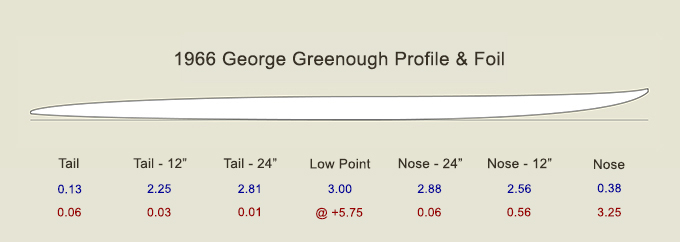 |
| |
The shortboard revolution started in 1966 - 67. George Greenough's kneeboard "Velo," a foam railed - hollowed out fiberglass bottom board inspired these first truly short surfboards. Greenough's planning hull designs featured very low entry rocker, nearly flat rocker from wide point to tail, and a foiled "S" deck. The distribution of foam in these designs was in fact a foil that offered great lift and acceleration. Surfing performance changed dramatically from trim and nose riding to accelerating high speed turns. |
| |
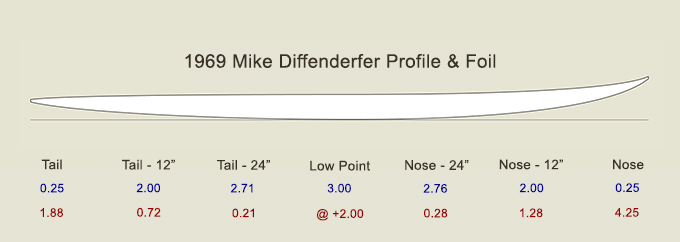 |
| |
The 60s also featured the emergence of Mike Diffenderfer's early shortboard designs. Diff's rockers and profiles introduced curves that fit into the tight energy rich curves in the pocket of a wave. These designs featured moderate entry, flatter mid board, the first notable tail rocker in shortboard design, and a foiled "S" deck. This was a remarkable if not quantum leap in surfboard design. Fundamentally, Diff's rockers and profiles allowed a surfboard to tap into the powerful energy available in critical parts of a wave. |
| |
 |
| |
The late 60s and early 70s saw the emergence of Dick Brewer's Mini Gun as the prototypical surfboard design. RB's rockers were similar to Diff's late 60s rockers featuring entry, mid board, and tail rocker. The Brewer Mini Gun fine tuned rocker from nose to tail. RB's designs, unlike Greenough and Diff's "S" decks, featured deck rocker that mimicked the bottom rocker. This profile would yield an even more efficient foil providing greater and more focused and functional lift, ultimately providing more acceleration, speed, and maneuverability to surfboard performance. |
| |
 |
| |
The 80s was a decade of relative stability in rocker and profile evolution. Surfboard design focused on refining the high volume shortboards of the 70s to create moderately shorter, thinner, narrower and ever more responsive boards. Attention to detail and fine tuning existing elements of design were the primary factors in rocker and profile evolution during this era. |
| |
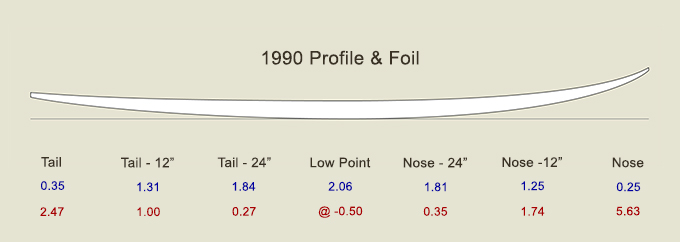 |
| |
The Momentum Generation's surfing inspired a dramatic change in rockers and profiles. Their surfboards featured extreme rockers, very thin profiles and foils, deep concave arrays, and narrow outlines. The Glass Slipper design was the foundation for the evolution of rocker and profile designs over the last 30 years. |
| |
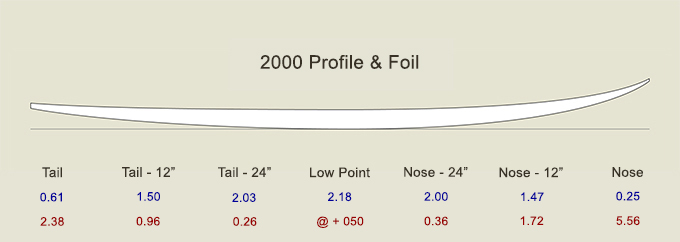 |
| |
By the year 2000 the Glass Slipper had evolved moderately from the extreme rockers, extremely thin profiles and foils, and extremely narrow outlines of the early 1990s. These designs featured moderated and nuanced variations to all design elements - moderated entry and tail rocker, moderated distribution of volume in profile and foil, moderately more surface area in the outline, and consequently moderately more volume overall. |
| |
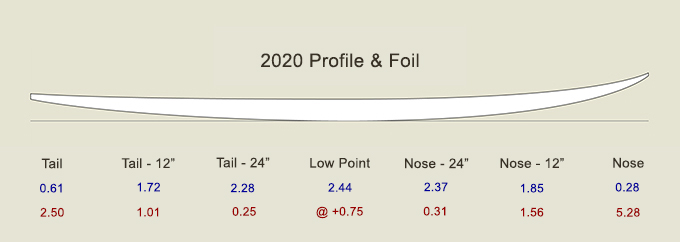 |
| |
The 21st century has seen moderation of these extreme rockers and profiles. Shortboard rockers and profiles continue to evolve and improve driven by practical observations of surfing and surfboard performance. The evolution and nuanced moderation of design elements makes today's contemporary shortboard a constantly evolving versatile and efficient design. |
| |
|
| |
< top of page > |
| |
EVOLUTION of ROCKERS and PROFILES 1990 to 2020 |
| |
|
| |
October 9, 2020 Updated November 30, 2023 |
| |
|
| |
Rocker is an extremely significant element in the design of a surfboard.
It's often said a great surfboard has magic rocker. Well designed rocker is the
foundation of a great shape. Bottom rocker and a well foiled profile are
essential to great performance from a surfboard. Bottom rocker is generally the
first design element a shaper puts into a surfboard. Once the bottom rocker is
established the shaper will proceed to add the other elements of design to a
shape.
Evolution is constant in surfboard design. Sometimes evolution in surfboard design is incremental and sometimes quantum. Rockers constantly evolve. Every shape and every surf session offers opportunity for observation and nuanced changes in design. Generally, these edits and tweaks are incremental in nature, but over time these incremental changes add up to vast improvements in design and performance. The following images illustrate the evolution of rockers, profiles, and foils from 1990 to 2020. The time interval between illustrations can make changes both more and less notable. Images over shorter intervals do not illustrate changes as well as over longer intervals. Images on longer intervals better illustrate changes. Images on 2 year intervals illustrate incremental evolution of rockers, profiles, and foils. Images on 10 year intervals illustrate notable evolution and development of rockers, profiles, and foils. Images on 30 year interval illustrates a quantum and dramatic evolution in rockers, profiles, and foils. The first set of images illustrates incremental rocker, profile and, foil evolution every two years from 2000 to 2020. The second set of images illustrates more notable than incremental rocker, profile and, foil evolution every ten years from 1990 to 2020. The final set of images illustrates quantum rocker, profile, and foil evolution from 1990 to 2020 in one thirty year time interval. As noted, day to day, week to week, and year to year, incremental design evolution is not particularly notable. The longer the time interval between evolving rocker, profile and foil designs illustrated in these images the more notable the design evolution. Over time incremental improvements in design yield quantum improvements in design. |
| |
|
| |
ROCKERS and PROFILES 2000 to 2020 - TWO YEAR INTERVALS |
| |
|
| |
Rocker values are in red. Thickness values are in blue. |
| |
|
| |
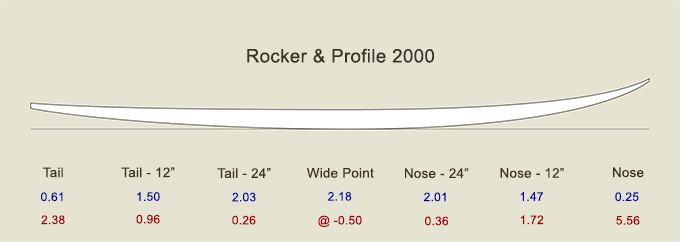 |
| |
2000 Glass Slipper 6' 2" x 18 1/4" x 2 3/16" - Less entry rocker than 1990 Glass Slipper, Speed Box mid board, less tail rocker, low volume profile and foil, slightly thicker nose. |
| |
 |
| |
2002 Glass Slipper 6' 2" x 18 1/2" x 2 3/16" - Less entry rocker, Speed Box mid board, more tail rocker, low volume profile and foil, slightly thicker nose. |
| |
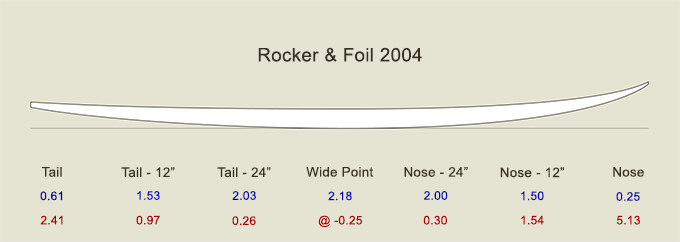 |
| |
2004 Glass Slipper 6' 2" x 18 5/8" x 2 3/16" - Less entry rocker, Speed Box mid board, lower tail rocker, low volume profile and foil, slightly thinner nose. |
| |
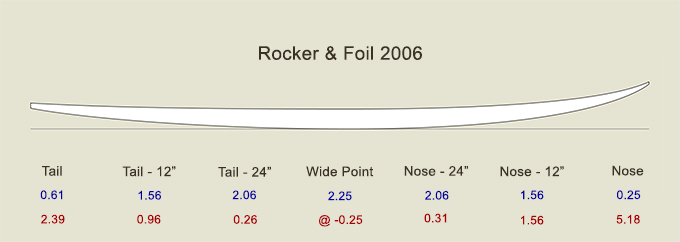 |
| |
2006 Glass Slipper 6' 1" x 18 5/8" x 2 1/4" - More entry rocker, Speed Box mid board, lower tail rocker, low volume profile and foil, slightly thicker nose. |
| |
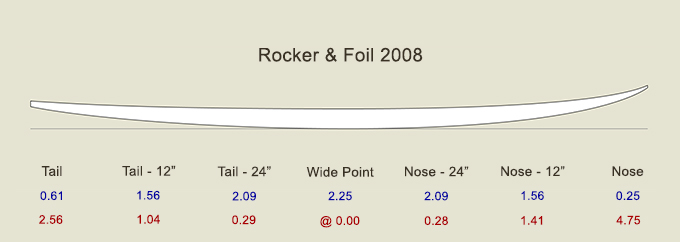 |
| |
2008 Relaxed Entry 6' 1" x 18 3/4" x 2 1/4" - Beginning of relaxed entry rocker designs featuring notably lower entry rocker, Speed Box mid board, more tail rocker, low to moderate volume profile and foil, slightly thicker nose and tail. |
| |
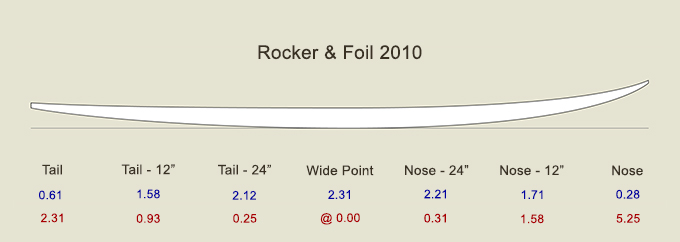 |
| |
2010 Relaxed Entry 6' 0" x 18 3/4" x 2 5/16" Relaxed entry rocker evolves - low entry rocker, Speed Box mid board, more tail rocker, low to moderate volume profile and foil, slightly thicker nose and tail. |
| |
 |
| |
2012 Relaxed Entry 6' 0" x 18 3/4" x 2 5/16" - The designs begin to have more volume - Relaxed entry rocker, Speed Box mid board, notably more tail rocker, moderate volume profile and foil, thicker nose and tail. |
| |
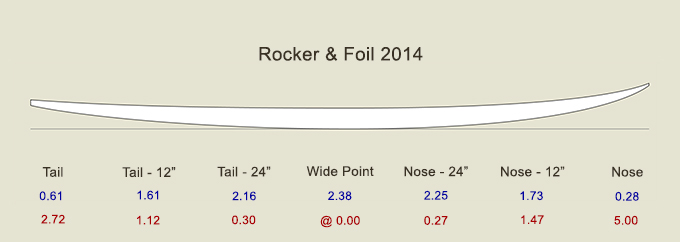 |
| |
2014 Relaxed Entry 6' 0" x 18 7/8" x 2 3/8" - Relaxed rocker maxes out - notably lower entry rocker, Speed Box mid board, significant tail rocker, moderate volume profile and foil, thicker throughout. |
| |
 |
| |
2016 Relaxed Entry 6' 0" x 18 7/8" x 2 3/8" - Relaxed Entry designs moderated further - more entry rocker, Speed Box mid board, less tail rocker, moderate volume profile and foil, thicker nose. |
| |
 |
| |
2018 Relaxed Entry 5' 11" x 18 3/4" x 2 5/16" - Relaxed Entry designs evolve - lower entry rocker, Speed Box mid board, less tail rocker, moderate volume profile and foil, thicker nose and tail. |
| |
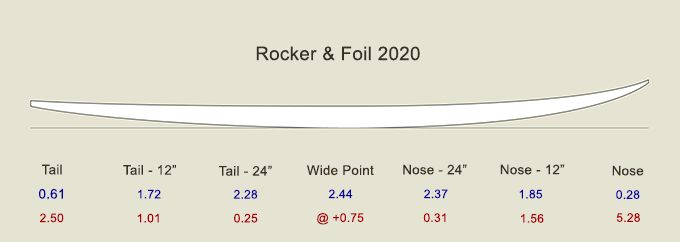 |
| |
2020 Contemporary Performance Shortboard 5' 11" x 19" x 2 7/16" - Contemporary Performance Shortboard featuring nuanced entry rocker, mid board Speed Box shifted further forward, moderately low tail rocker, moderate volume, well defined profile and foil, thicker nose and thinner tail. |
| |
|
| |
ROCKERS and PROFILES 1990 to 2020 - TEN YEAR INTERVALS |
| |
|
| |
The set of images compares 1990, 2000, 2010, and 2020 rockers and profiles on 10 year intervals. The longer intervals notably illustrate evolution and development of these rockers, profiles, and foils. |
| |
 |
| |
1990 Glass Slipper 6' 2" x 17 3/4" x 2" - Substantial and extreme entry rocker, Speed Box mid board, moderate tail rocker, extremely low volume profile and foil. |
| |
 |
| |
2000 Glass Slipper 6' 1" x 18 1/2" x 2 3/16" - Maximum entry rocker, longer Speed Box mid board, more tail rocker, low volume profile, slightly thicker nose. |
| |
 |
| |
2010 Relaxed Entry 6' 0" x 18 3/4" x 2 5/16" - Relaxed entry rocker evolves - low entry rocker, Speed Box mid board, more tail rocker, moderate volume profile and foil, slightly thicker nose and tail. |
| |
 |
| |
|
| |
2020 Contemporary Performance Shortboard 5' 11" x 18 7/8" x 2 7/16" - Contemporary Performance Shortboard featuring nuanced entry rocker, mid board Speed Box shifted further forward, moderately low tail rocker, moderate volume, well defined profile and foil, thicker nose and thinner tail. |
| |
|
| |
ROCKERS and PROFILES 1990 to 2020 - THIRTY YEAR INTERVAL |
| |
|
| |
The third and final set of images, 1990 rocker, profile, and foil and 2020 rocker, profile, and foil illustrate how incremental design improvements over time become quantum improvements. The design evolution from the 1990 Glass Slipper to the 2020 - 2023 Contemporary Performance Shortboard has been dramatic. Performance Shortboard designs will no doubt continue to evolve in sync with the evolution of performance surfing. |
| |
 |
| |
1990 Glass Slipper - Rocker, profile, and foil - Extreme entry rocker, mid board Speed Box, significant tail rocker, extremely low volume profile with strong foil. Evolution and de-evolution in an extreme design. Evolutionary as the foundation of all contemporary performance shortboards and de-evolutionary as an extremely impractical and difficult board to ride due to the exaggerated rocker, and extremely low volume and surface area. |
| |
 |
| |
2020 Contemporary Performance Shortboard - Rocker, profile, and foil - Moderate entry rocker, Speed Box mid board shifted forward, moderately low tail rocker, moderate volume, nuanced profile and foil, thicker nose and thinner tail. An evolving and well executed design. |
| |
|
| |
< top of page > |
| |
ACCELERATION and FOILED PROFILES |
| |
|
| |
February 6, 2021 Updated March 10, 2023
SURFBOARD PROFILES and FOILS Profiles and foils serve many functions in surfboard design. Not the least of these is acceleration. The two elements of a design's profile and foil are the bottom rocker and the deck rocker. Together they form the design's profile and foil. A well designed profile is a foil. See foil and Brounelli Principle below. Designing acceleration into a profile and foil includes a bottom rocker that fits naturally and comfortably in the critical parts of a wave with curves that tap into a wave's energy. A rocker like this offers or provides the design with acceleration, speed, maneuverability and control. The profile and foil of a design also includes the deck rocker. The relation of the deck rocker to the bottom rocker accounts for the distribution of volume in the profile and foil, the other primary factor in distribution of volume for the whole design is the board's surface area determined by the outline. A foiled profile distributes the volume in a manner that creates lift and reduces drag, ultimately providing acceleration and creating and maintaining speed. Distribution of volume effects how and to what extent a surfer displaces water by weighting and unweighting the board's bottom, profile, and rails. This basic shortboard technique or style accelerates the surfboard and generates and maintains the speed required to perform the vast array of maneuvers common to contemporary surfing. Engaging, holding and releasing the bottom, profile, and rails in the face of a wave amplifies the lift and reduces the drag components of a foil moving through water. This technique is functional in all conditons. It may be performed across the whole spectrum of surf conditions and venues - critical, high quality, fun, or marginal. A foiled profile contributes to all performance features - acceleration, speed, maneuverability, and control. The distribution of volume in a profile creates the performance features of this essential design element. As previously mentioned, a well designed profile is a foil that creates lift and energy and reduces drag by harnessing energy from a wave as it moves through water. This lift generated energy and reduced drag create the acceleration and speed that a surfboard offers a surfer. This occurs when water flows along the bottom of a board creating a force perpendicular to that flow generating lift that is substantially greater than the drag of the board in the water. The lift and energy generated by the foil is then transferred into the the acceleration, speed, and maneuvers performed while surfing. Tuning and controlling the lift to surfer and conditions with design features is an essential part of surfboard design. PHYSICS and SCIENCE of PROFILES and FOILS In physics and fluid mechanics, a foil is a solid object with a shape that when placed in a moving fluid at a suitable angle of attack the lift on the object, the force generated perpendicular to the fluid flow is substantially greater than the drag, a force parallel to the fluid flow. A foiled profile of a surfboard is a shape that when under the power of a wave and being maneuvered on and through the water by a surfer transfers the generated lift and energy into forward acceleration. The greater the lift the greater the reduction in drag. Reduced drag yields greater acceleration and speed in every surfboard design. BROUNELLI'S PRINCIPLE APPLIED to SURFBOARD FOILS Brounelli's principle states that increased speed of a fluid on a surface occurs simultaneously with a reduction of pressure on the same surface. The reduction of pressure results in a transfer of energy we feel as lift and forward acceleration in a surfboard. The distribution of volume in a foiled surfboard profile benefits from this principle. When a mass of fluid, water in surfboard design and performance, is flowing horizontally from a region of higher pressure in the entry to a region of lower pressure in the tail at increasing speed there is more pressure aft on the surfboard than forward. This yields a force on the shape, the surfboard, accelerating it along the horizontal line of it's "x" axis. This explains how a surfboard foil will perform when the distribution of foam varies from thinner, to thicker, to thinner from nose to tail, providing lift that is transfered into acceleration, speed, and maneuverability. LINK Wikipedia Overview of Foils and Fluid Mechanics |
| |
|
| |
< top of page > |
| |
TUNING ROCKERS for ACCELERATION and RELEASE 2017 |
| |
|
| |
March 28, 2017 Updated March 1, 2023 |
| |
|
| |
Every moment in surfing, in or out of the water, offers us opporunities to
explore and evolve surfboard design. Surfing on Kauai with Dave Beck and Randy
Davis motivated us to work on rockers that performed critical maneuvers in
fast, vertical barreling waves typical to Kauai. This required a rocker that
fit in critical sections of waves providing board and surfer the best
opportunity to tap into the energy on offer in a wave and perform radical
critical maneuvers. The theory of designing rocker that fits into critical
sections to generate acceleration, projection, speed, and maneuverability dates
to the dramatic early stages of the shortboard design revolution from 1966 to
1969. Surfboard design focused on trim to that point. Over night the focus
pivoted to radical, high speed turns with surfers accelerating horizontally in
and out of the pocket and vertically from top to bottom. Surfing performance
was deeper in the pocket, more powerful off the bottom and ever more critical
in the lip. This revolutionary approach to surfing was a striking contrast to
the elegant dance of trim and nose riding.
The Modern Surfboard for the convenience of this discussion dates to the early 20th Century and the designs rode by Duke Kahanmoku, George Freeth, Tom Blake, Bob Simmons, and other surfing pioneers. These designs focused on trim. They were very long, very thick, and very flat. They had a lot of surface area and a lot of volume. They had very little rocker. The introduction of surfboard rocker is credited to Bob Simmons. One of his many designs was the Simmons Spoon featuring a kicked up nose and subtle curve from nose to tail. The Spoon was designed to fit in critical sections of waves and was the beginning of rocker as a feature in surfboard design. Surfing and surfboard design did not shift it's focus beyond trim, nose riding, and steering boards around as much as turning them until the mid 60s. Shortboard pioneers changed all that from 1966 to 1969. Surfing and surfboard design focused on high speed turns, accelerating and projecting in and out of the pocket and barrels and vertically up and down the face of waves. Boards were shorter, narrower, and thinner. They lost considerable surface area and volume - key elements of trimming and nose riding designs. The loss of surface area and volume resulted in less energy transferring into boards. Accordingly, surfers were required to find new techniques for taping into the energy in a wave. This was a primary factor in the evolution of tail rocker in surfboard design. A design that fit effortlessly in the tight, critical sections of a wave had the ability to tap into the abundant energy waves had to offer. Low, nearly non existent tail rocker carried over from the last of the highly evolved LBs to the first shortboards. Surfers and designers were still attached to the low tail rocker profiles. The developing problem was that these rockers did not fit well into the critical energy rich parts of waves that surfing was now exploring. Ultimately these designs were not as effecient as they could be. Realizing that more curve was required for a board to fit into the pocket of waves a few surfer shapers started to incorporate more rocker into their shapes that mimicked the curves we find in the most vertical and critical part of any wave. These curves allowed boards to tap into the waves' energy and ultimately allows the surfer to maximize all the performance possibilities on a wave. Rockers continued to evolve over decades of surfing and design following trends of ever developing surfing performance. Generally rocker evolution came as incremental changes and occasionally as quantum changes. Current rocker adjustments focus on maximizing acceleration and release in all conditions. These ideas got started when Randy Davis, long time Kauai charger and Santa Cruz ex-pat, brought up maximizing performance when navigating barrels and carving turns in barreling sections, turning off and under the lip, and down carving in critical sections of fast vertical hollow waves. Initially we thought increasing tail rocker from the wide point and continuing to accelerate the rocker through the tail would promote acceleration and release. This would offer better release and allow the surfer to keep the rail firmly in the water in these critical conditions. Dave Beck entered the discusion pointing out we didn't want to risk losing acceleration, projection, and speed as a result of this rocker adjustment. Ultimately, we developed a curve that maintained speed box properties from the wide point to the center of the surfer's stance shifting the speed box moderately forward and adding accelerated curve aft of the speed box through the tail. This rocker is a SPEED BOX rocker with accelerated tail rocker. It's not intended to be a specialty rocker designed for specific conditions. Specialty boards are great, but by their nature may only excel in a narrow range of conditions. It's rather another step in the evolution and development of rockers for all conditions. It's a design option that will perform well in moderate and all around conditions, and will excel in the vertical and hollow sections of high quality waves. The images and dimensions below illustrate rockers and profiles pre 2017 and rockers and profiles with the adjustments made in 2017. In these illustrations thickness is indicated in blue and rocker is indicated in red. Note the subtle shift forward of the Speed Box in the 2017 rocker image, the moderately lower entry rocker, and the accelerated tail rocker. |
| |
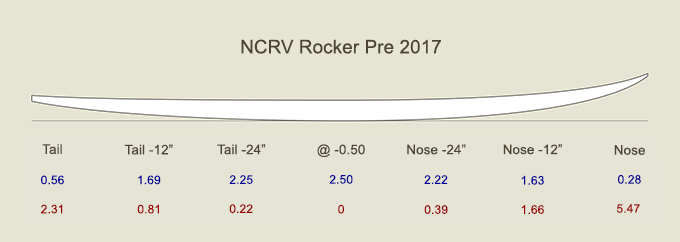 |
| |
Rocker and Profile pre 2017. Speed box and power core are centered 1/2" behind center. Notable entry rocker and lower tail rocker. Classic shortboard rocker and profile concepts. |
| |
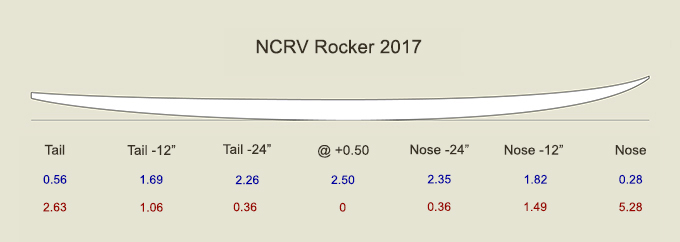 |
| |
Rocker and profile with 2017 rocker adjustments. Speed box and power core are shifted forward 1/2" from center. Nuanced entry rocker and accelerated tail rocker fit the curves of critical waves. |
| |
|
| |
< top of page > |